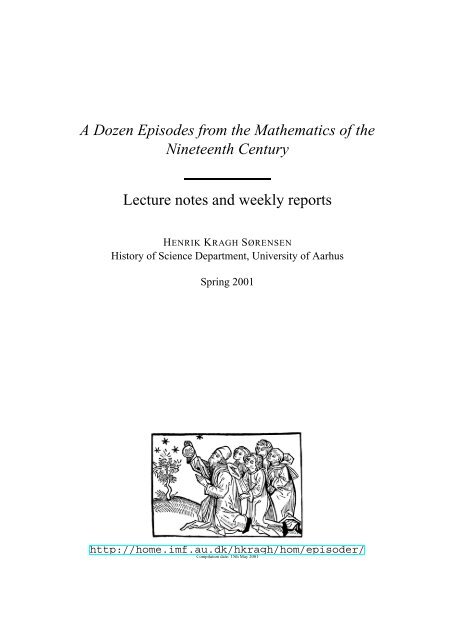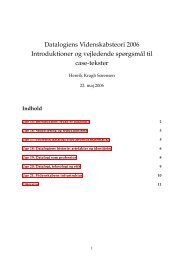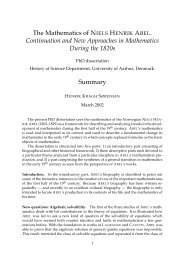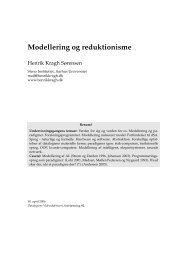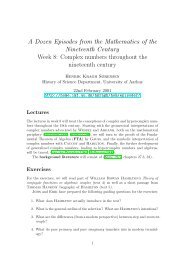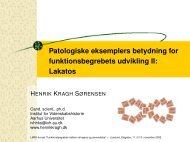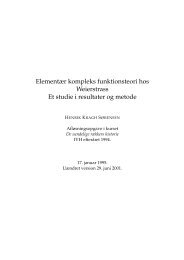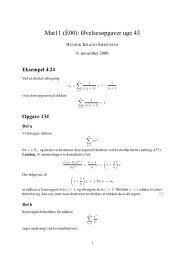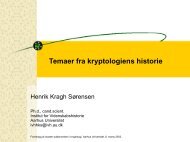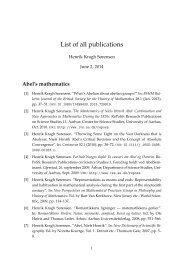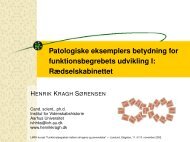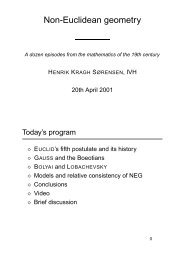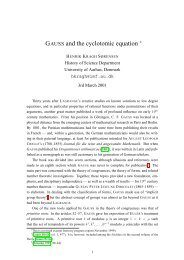A Dozen Episodes from the Mathematics of the Nineteenth Century ...
A Dozen Episodes from the Mathematics of the Nineteenth Century ...
A Dozen Episodes from the Mathematics of the Nineteenth Century ...
You also want an ePaper? Increase the reach of your titles
YUMPU automatically turns print PDFs into web optimized ePapers that Google loves.
A <strong>Dozen</strong> <strong>Episodes</strong> <strong>from</strong> <strong>the</strong> Ma<strong>the</strong>matics <strong>of</strong> <strong>the</strong><br />
<strong>Nineteenth</strong> <strong>Century</strong><br />
Lecture notes and weekly reports<br />
HENRIK KRAGH SØRENSEN<br />
History <strong>of</strong> Science Department, University <strong>of</strong> Aarhus<br />
Spring 2001<br />
http://home.imf.au.dk/hkragh/hom/episoder/<br />
Compilation date: 15th May 2001
2 Contents<br />
Contents<br />
Week 5: Welcome 3<br />
The dozen episodes in schematic form 4<br />
Week 7: Institutional and national aspects <strong>of</strong> nineteenth century ma<strong>the</strong>matics 9<br />
Week 8: Complex numbers throughout <strong>the</strong> nineteenth century 12<br />
Week 9: Algebraic solution <strong>of</strong> equations 14<br />
Week 10: Algebra and number <strong>the</strong>ory 16<br />
Week 11: Rigor in analysis – continuity and differentiability 18<br />
Week 12: Rigor in analysis – infinite series 20<br />
Week 13: Fourier series and integration 21<br />
Week 14: Theory <strong>of</strong> complex functions 23<br />
Week 16: Non-Euclidean geometry 25<br />
Week 17: Differential geometry and models <strong>of</strong> non-Euclidean geometry 27<br />
Week 18: Projective geometry 29<br />
Week 19: Axiomatization <strong>of</strong> set <strong>the</strong>ory 31<br />
Complete list <strong>of</strong> references 34<br />
A <strong>Dozen</strong> <strong>Episodes</strong> <strong>from</strong> <strong>the</strong> Ma<strong>the</strong>matics <strong>of</strong> <strong>the</strong> <strong>Nineteenth</strong> <strong>Century</strong> HKS, Spring 2001
Week 5: Welcome 3<br />
Week 5: Welcome<br />
At <strong>the</strong> introductory lecture and welcome meeting, <strong>the</strong> course was briefly presented and<br />
<strong>the</strong> schedule was made. Unfortunately, it was impossible to accomodate all wishes but we<br />
managed to agree upon <strong>the</strong> following schedule:<br />
The schedule for <strong>the</strong> course was laid out as follows:<br />
Lectures on Fridays 14–16. A room will be announced.<br />
Exercises on Tuesdays 12–14 at IVH Aud.<br />
However, to accomodate everybody, please email me if you are able to attend<br />
exercises on Thursdays 16-18.<br />
The first lecture and exercises will be held in week 7, ie. if no fur<strong>the</strong>r notice is given,<br />
First exercises on Tuesday 13th February 12.15 in IVH Aud.<br />
For <strong>the</strong> exercises in week 7, please read <strong>the</strong> texts 1–3 and study <strong>the</strong> questions posed on<br />
<strong>the</strong> weekly report for week 7.<br />
I would strongly encourage two participants to volunteer for <strong>the</strong> exercises in week 8,<br />
ie. texts 4–5. Fur<strong>the</strong>r arrangements will be made on Tuesday 13th.<br />
All material handed out will be placed on Semesterhylden at <strong>the</strong> rear <strong>of</strong> <strong>the</strong> IVH<br />
library. Later in <strong>the</strong> term, participants will be asked to pay for <strong>the</strong> material handed out for<br />
<strong>the</strong> exercises.<br />
Besides <strong>the</strong> material handed out, background literature for <strong>the</strong> lectures will draw upon<br />
<strong>the</strong> 2nd and 3rd volume <strong>of</strong> M. KLINE’s Ma<strong>the</strong>matical thought <strong>from</strong> ancient to modern<br />
times (?). The episodes will deal with material covered by chapters 26, 27, 31, 32 (volume<br />
2) and 34, 35, 36, 37, 38, 40, 41, 42, 43, 49 (volume 3). Each weekly report will include<br />
references to <strong>the</strong> relevant chapters. Ano<strong>the</strong>r good supplement is I. GRATTAN-GUINNESS’<br />
book The Fontana history <strong>of</strong> ma<strong>the</strong>matical sciences (?).<br />
For <strong>the</strong> lectures and exercises in week 7, <strong>the</strong> most relevant part <strong>of</strong> (?) is chapter 26.<br />
The material handed out for <strong>the</strong> exercises also constitutes part <strong>of</strong> <strong>the</strong> background literature<br />
<strong>of</strong> <strong>the</strong> lectures.<br />
For <strong>the</strong> lectures and exercises in week 8, <strong>the</strong> background literature consists <strong>of</strong> (?,<br />
chapters 27.3, 32).<br />
Useful links<br />
• http://home.imf.au.dk/hkragh/hom/episoder/: Homepage <strong>of</strong> <strong>the</strong><br />
course<br />
• http://www.ams.org/mathscinet/: Ma<strong>the</strong>matical Reviews online (by AMS)<br />
Henrik Kragh Sørensen<br />
hkragh@imf.au.dk<br />
Office H1.19, phone 3508<br />
A <strong>Dozen</strong> <strong>Episodes</strong> <strong>from</strong> <strong>the</strong> Ma<strong>the</strong>matics <strong>of</strong> <strong>the</strong> <strong>Nineteenth</strong> <strong>Century</strong> HKS, Spring 2001
4 The dozen episodes in schematic form<br />
The dozen episodes in schematic form<br />
Week 7: Institutional and national aspects <strong>of</strong> nineteenth century ma<strong>the</strong>matics<br />
Exercises: On <strong>the</strong> social and institutional setting <strong>of</strong> ma<strong>the</strong>matics in <strong>the</strong> nineteenth century:<br />
(Struik 1954, 201–227), (Grattan-Guinness 1994b), and (Schubring 1994)<br />
Presentation <strong>of</strong> <strong>the</strong> episodes and historiographical remarks: temporal, disciplinary, and<br />
national.<br />
The social and political background <strong>of</strong> <strong>the</strong> French Revolution and <strong>the</strong> Napoleonic<br />
Wars. The institutionalizing <strong>of</strong> ma<strong>the</strong>matics in France and Germany; <strong>the</strong> emergence <strong>of</strong><br />
a pr<strong>of</strong>essional class <strong>of</strong> ma<strong>the</strong>maticians. The change <strong>of</strong> ma<strong>the</strong>matical interaction; <strong>the</strong><br />
creation <strong>of</strong> <strong>the</strong> first pr<strong>of</strong>essional journals, in particular those by GERGONNE 1810 and<br />
CRELLE 1826. Ma<strong>the</strong>matics in Britain and in Scandinavia.<br />
Week 8: Complex numbers throughout <strong>the</strong> nineteenth century<br />
Biography: WESSEL<br />
Exercises: On HAMILTON’s construction <strong>of</strong> complex numbers as pairs <strong>of</strong> time steps:<br />
(Hamilton 1837, 76–84) and (Hankins 1980, 268–275)<br />
Geometric representation <strong>of</strong> complex numbers with WESSEL and ARGAND. The low<br />
and high priority questions concerning complex numbers among ma<strong>the</strong>maticians. Symbolic<br />
approach to complex numbers leading to quaternions and hypercomplex numbers;<br />
CAUCHY and HAMILTON.<br />
Week 9: Algebraic solution <strong>of</strong> equations<br />
Biography: GALOIS<br />
Exercises: A selection <strong>from</strong> Gauss’ division <strong>of</strong> <strong>the</strong> circle: (Gauss 1986, 407–428)<br />
The continuity <strong>from</strong> <strong>the</strong> algebraic investigations <strong>of</strong> LAGRANGE. The works <strong>of</strong> RUFINI and<br />
ABEL concerning <strong>the</strong> quintic equation. Solubility by o<strong>the</strong>r means. Problem <strong>of</strong> algebraic<br />
solubility. GALOIS’ <strong>the</strong>ory. JORDAN’s assimilation <strong>of</strong> Galois-<strong>the</strong>ory. The emergence <strong>of</strong><br />
<strong>the</strong> <strong>the</strong>ory <strong>of</strong> groups.<br />
Week 10: Algebra and number <strong>the</strong>ory, division problems, reciprocity, and FERMAT’s<br />
Last Theorem<br />
Biography: GAUSS<br />
Exercises: HÖLDER on <strong>the</strong> concept <strong>of</strong> quotient groups and <strong>the</strong> JORDAN-HÖLDER Theorem:<br />
(Hölder 1889, 26–38)<br />
GAUSS’ Disquisitiones arithmeticae; <strong>the</strong> division <strong>of</strong> <strong>the</strong> circle with GAUSS, <strong>the</strong> division<br />
<strong>of</strong> <strong>the</strong> lemniscate with ABEL, and Abelian equations. Quadratic (and higher) reciprocity.<br />
The importance <strong>of</strong> FERMAT’s Last Theorem for <strong>the</strong> evolution <strong>of</strong> abstract algebra.<br />
A <strong>Dozen</strong> <strong>Episodes</strong> <strong>from</strong> <strong>the</strong> Ma<strong>the</strong>matics <strong>of</strong> <strong>the</strong> <strong>Nineteenth</strong> <strong>Century</strong> HKS, Spring 2001
The dozen episodes in schematic form 5<br />
Week 11: Rigor in analysis<br />
Biography: WEIERSTRASS<br />
Exercises: BOLZANO (Russ 1980, 159–168, 171–172, 174–176) and CAUCHY (Grabiner 1981,<br />
167–168) on <strong>the</strong> definition <strong>of</strong> continuity and <strong>the</strong> intermediate value <strong>the</strong>orem<br />
Focus on limits and inequalities. CAUCHY’s introduction <strong>of</strong> continuity and differentiability<br />
in Cours d’analyse and Resumé des leçons. CAUCHY’s innovation founded in <strong>the</strong><br />
previous generation, primarily LAGRANGE. The intermediate value <strong>the</strong>orem, importance<br />
and pro<strong>of</strong>s. BOLZANO. Real numbers, DEDEKIND and CANTOR. WEIERSTRASS. The<br />
WEIERSTRASS Monster.<br />
BJARNE AAGAARD will lecture on <strong>the</strong> biography <strong>of</strong> WEIERSTRASS, <strong>the</strong> philosophical<br />
<strong>the</strong>ory <strong>of</strong> LAKATOS, and <strong>the</strong> importance <strong>of</strong> WEIERSTRASS’ Monster for <strong>the</strong> development<br />
<strong>of</strong> analysis in <strong>the</strong> 19th century.<br />
Week 12: Theory <strong>of</strong> series and uniform convergence<br />
Biography: ABEL<br />
Exercises: SEIDEL’s pro<strong>of</strong> analysis (Seidel 1847, 35–45) and LAKATOS’ philosophy<br />
(Lakatos 1976, 127–141)<br />
CAUCHY’s numerical concept <strong>of</strong> equality based on limits as opposed to EULER’s formal<br />
equality. CAUCHY’s ideas about rigorous, critical revision <strong>of</strong> <strong>the</strong> <strong>the</strong>ory <strong>of</strong> infinite series:<br />
definition and criteria <strong>of</strong> convergence. ABEL’s reading <strong>of</strong> CAUCHY and <strong>the</strong> exception.<br />
Towards uniform convergence.<br />
Week 13: Fourier series and <strong>the</strong> concept <strong>of</strong> integrals<br />
Biography: FOURIER<br />
Exercises: RIEMANN and <strong>the</strong> integral concept (Riemann 1854, 227–244)<br />
FOURIER and <strong>the</strong> emergence <strong>of</strong> Fourier series <strong>from</strong> <strong>the</strong> <strong>the</strong>ory <strong>of</strong> heat. CAUCHY’s concept<br />
<strong>of</strong> <strong>the</strong> integral and his integral calculus. Convergence <strong>of</strong> Fourier series, CAUCHY<br />
and DIRICHLET, <strong>the</strong> Dirichlet conditions. Are all trigonometric series Fourier series?<br />
Do Fourier series represent <strong>the</strong> functions? Is Fourier series representation unique? RIE-<br />
MANN’s Habilitationsaufsatz, 1854. The Fundamental Theorem <strong>of</strong> <strong>the</strong> Calculus. CAN-<br />
TOR and <strong>the</strong> <strong>the</strong>ory <strong>of</strong> point sets. Uniqueness <strong>of</strong> representation. Replacement condition:<br />
JORDAN and bounded variation.<br />
Week 14: Theory <strong>of</strong> complex functions<br />
Biography: CAUCHY<br />
Exercises: WEIERSTRASS on power series and analytic functions (Weierstrass 1988, 63–<br />
70,93–97,127–130)<br />
Logarithms <strong>of</strong> negative numbers. GAUSS on integration in <strong>the</strong> complex plane. CAUCHY<br />
on integration along <strong>the</strong> sides <strong>of</strong> a rectangle. CAUCHY’s <strong>the</strong>ory <strong>of</strong> complex functions. Elliptic<br />
functions, <strong>the</strong> inversion by ABEL. RIEMANN’s <strong>the</strong>ory <strong>of</strong> complex functions. Briefly<br />
on WEIERSTRASS’ <strong>the</strong>ory. Differences between <strong>the</strong> <strong>the</strong>ories. Unification.<br />
A <strong>Dozen</strong> <strong>Episodes</strong> <strong>from</strong> <strong>the</strong> Ma<strong>the</strong>matics <strong>of</strong> <strong>the</strong> <strong>Nineteenth</strong> <strong>Century</strong> HKS, Spring 2001
6 The dozen episodes in schematic form<br />
Week 16: Non-Euclidean geometry<br />
Biography:<br />
Exercises: LOBACHEVSKY’s redefinition <strong>of</strong> parallels (Lobachevski 1955, 11–23)<br />
EUCLID’s geometry. The problematic fifth postulate (P5). Attemts at proving P5. The<br />
philosophical aspect: is geometry “true”? Correspondance. PLAYFAIR’s axiom and<br />
hyperbolic geometry. On <strong>the</strong> geometries <strong>of</strong> BOLYAI and LOBACHEVSKY. Video with<br />
JEREMY GRAY on <strong>the</strong> discovery <strong>of</strong> hyperbolic geometry.<br />
Week 17: Differential geometry<br />
Biography: RIEMANN<br />
Exercises: GAUSS’ intrinsic geometry and <strong>the</strong> concept <strong>of</strong> curvature (Gauss 1902, )<br />
Week 18: Projective geometry and <strong>the</strong> Erlanger programme<br />
Biography: PONCELET<br />
Exercises: HILBERT’s axiomatization <strong>of</strong> geometry<br />
Week 19: Ma<strong>the</strong>matics <strong>of</strong> <strong>the</strong> nineteenth century in hindsight<br />
Biography: HILBERT<br />
Exercises:<br />
Week 20: The <strong>the</strong>ory <strong>of</strong> sets (TERESE M. O. NIELSEN)<br />
Biography: CANTOR<br />
Exercises: ZERMELO<br />
A <strong>Dozen</strong> <strong>Episodes</strong> <strong>from</strong> <strong>the</strong> Ma<strong>the</strong>matics <strong>of</strong> <strong>the</strong> <strong>Nineteenth</strong> <strong>Century</strong> HKS, Spring 2001
The dozen episodes in schematic form 7<br />
References<br />
Gauss, C. F. (1986). Disquisitiones Arithmeticae. English Edition. New York, Berlin,<br />
Heidelberg, Tokyo: Springer-Verlag. Edited by A. A. Clarke and W. C. Waterhouse.<br />
Gauss, K. F. (1902). General Investigations <strong>of</strong> Curved Surfaces <strong>of</strong> 1827 and 1825.<br />
Princeton (NJ): Princeton University Library. Translated and edited by J. C. Morehead<br />
and A. M. Hiltebeitel.<br />
Grabiner, J. V. (1981). The Origins <strong>of</strong> Cauchy’s Rigorous Calculus. Cambridge<br />
(Mass.): MIT Press.<br />
Grattan-Guinness, I. (Ed.) (1994a). Companion encyclopedia <strong>of</strong> <strong>the</strong> history and philosophy<br />
<strong>of</strong> <strong>the</strong> ma<strong>the</strong>matical sciences. London: Routledge. 2 vols.<br />
Grattan-Guinness, I. (1994b). France. In volume 2 <strong>of</strong> Grattan-Guinness 1994a, Chapter<br />
11.1, pp. 1430–1441.<br />
Hamilton, W. R. (1837). Theory <strong>of</strong> conjugate functions, or algebraic couples; with a<br />
preliminary and elementary essay on algebra as <strong>the</strong> science <strong>of</strong> pure time. In The<br />
ma<strong>the</strong>matical papers <strong>of</strong> Sir William Rowan Hamilton, Volume 3, pp. 3–96. Cambridge:<br />
at <strong>the</strong> University Press. First published Trans. Roy. Irish Acad. vol. XVIII<br />
(1837), pp. 293–422. Read on 4 November 1833 and 1 June 1835.<br />
Hankins, T. L. (1980). Sir William Rowan Hamilton. Baltimore and London: The Johns<br />
Hopkins University Press.<br />
Hölder, O. (1889). Zurückführung einer beliebigen algebraischen Gleichung auf eine<br />
Kette von Gleichungen. Ma<strong>the</strong>matische Annalen 34, 26–56.<br />
Lakatos, I. (1976). Pro<strong>of</strong>s and Refutations. The Logic <strong>of</strong> Ma<strong>the</strong>matical Discovery.<br />
Cambridge: Cambridge University Press.<br />
Lobachevski, N. (1955). Geometrical researches on <strong>the</strong> <strong>the</strong>ory <strong>of</strong> parallels. In<br />
R. Bonola (Ed.), Non-Euclidean Geometry. New York: Dover Publications, Inc.<br />
Translated by G. B. Halsted. German orignal published 1840.<br />
Riemann, B. (1854). Ueber die Darstellbarkeit einer Function durch eine<br />
trigonometrische Reihe. In The Collected Works <strong>of</strong> Bernard Riemann (Gesammelte<br />
ma<strong>the</strong>matische Werke und wissenschaftlicher Nachlass), pp. 227–264. New York:<br />
Dover Publications. First published Abhandlungen der Königlichen Gesellschaft<br />
der Wissenschaften zu Göttingen, volume 13.<br />
Russ, S. B. (1980). A Translation <strong>of</strong> Bolzano’s Paper on <strong>the</strong> Intermediate Value Theorem.<br />
Historia Ma<strong>the</strong>matica 7(2), 156–185.<br />
Schubring, G. (1994). Germany to 1933. In volume 2 <strong>of</strong> Grattan-Guinness 1994a,<br />
Chapter 11.2, pp. 1442–1456.<br />
Seidel, P. L. (1847). Note über eine Eigenschaft der Reihen, welche discontinuirliche<br />
Functionen darstellen. In H. Liebmann (Ed.), Die Darstellung ganz willkürlicher<br />
Functionen durch Sinus- und Cosinusreihen von Lejeune Dirichlet (1837) und Note<br />
über eine Eigenschaft der Reihen, welche discontinuirliche Functionen darstellen<br />
von Philipp Ludwig Seidel (1847). Leipzig: Verlag von Wilhelm Engelmann. First<br />
published Abhandl. der Math. Phys. Klasse der Kgl. Bayerischen Akademie der<br />
Wissenschaften, V (1847), 381–394.<br />
A <strong>Dozen</strong> <strong>Episodes</strong> <strong>from</strong> <strong>the</strong> Ma<strong>the</strong>matics <strong>of</strong> <strong>the</strong> <strong>Nineteenth</strong> <strong>Century</strong> HKS, Spring 2001
8 The dozen episodes in schematic form<br />
Struik, D. J. (1954). A concise history <strong>of</strong> ma<strong>the</strong>matics. London: G. Bell and Sons ltd.<br />
First published 1948.<br />
Weierstrass, K. (1988). Einleitung in die Theorie der analytischen Funktionen. Vorlesung<br />
Berlin 1878, Volume 4 <strong>of</strong> Dokumente zur Geschichte der Ma<strong>the</strong>matik.<br />
Braunsweig: Deutsche Ma<strong>the</strong>matiker-Vereinigung, Vieweg & Sohn. Notes taken<br />
by A. Hurwitz. Edited by P. Ullrich.<br />
A <strong>Dozen</strong> <strong>Episodes</strong> <strong>from</strong> <strong>the</strong> Ma<strong>the</strong>matics <strong>of</strong> <strong>the</strong> <strong>Nineteenth</strong> <strong>Century</strong> HKS, Spring 2001
Week 7: Institutional and national aspects <strong>of</strong> nineteenth century ma<strong>the</strong>matics 9<br />
Week 7: Institutional and national aspects <strong>of</strong> nineteenth<br />
century ma<strong>the</strong>matics<br />
Lectures<br />
The lectures in week 7 will serve a three-fold purpose:<br />
1. Introductions <strong>of</strong> <strong>the</strong> course, <strong>the</strong> lecturer, and <strong>the</strong> participants will be given.<br />
2. Based on <strong>the</strong> selection <strong>of</strong> episodes, some historiographical remarks will be given<br />
concerning central choices.<br />
3. The main core <strong>of</strong> <strong>the</strong> lectures and <strong>the</strong> exercises will deal with <strong>the</strong> external — institutional<br />
and social — background <strong>of</strong> ma<strong>the</strong>matics in <strong>the</strong> nineteenth century.<br />
The background literature will consist <strong>of</strong> (Kline 1972, chapter 26).<br />
Apart <strong>from</strong> <strong>the</strong> literature handed out, (Struik 1981) gives a general introduction to <strong>the</strong><br />
ma<strong>the</strong>matics <strong>of</strong> <strong>the</strong> early nineteenth century and its close links with <strong>the</strong> dramatic changes<br />
that took place on <strong>the</strong> political scene. Many o<strong>the</strong>r general histories <strong>of</strong> ma<strong>the</strong>matics dealing<br />
with <strong>the</strong> nineteenth century can be named, eg. (Klein 1967, Kline 1972). Of course,<br />
expert detailed studies also exist <strong>of</strong> almost all <strong>the</strong> episodes covered in this course. References<br />
will be given at <strong>the</strong> appropriate places.<br />
The impact <strong>of</strong> <strong>the</strong> French Revolution on ma<strong>the</strong>matics education has been described in<br />
eg. (Grattan-Guinness 1990).<br />
The evolution <strong>of</strong> ma<strong>the</strong>matics in Germany and its relation to <strong>the</strong> reform <strong>of</strong> ma<strong>the</strong>matics<br />
education has been described in (Biermann 1988, Jahnke 1990, Schubring 1993).<br />
The British ma<strong>the</strong>matical community were largely centered in Cambridge and in<br />
Dublin. The scene in Cambridge has recently been studied in a speciale at our department,<br />
(Nielsen 2001).<br />
A <strong>Dozen</strong> <strong>Episodes</strong> <strong>from</strong> <strong>the</strong> Ma<strong>the</strong>matics <strong>of</strong> <strong>the</strong> <strong>Nineteenth</strong> <strong>Century</strong> HKS, Spring 2001
10 Week 7: Institutional and national aspects <strong>of</strong> nineteenth century ma<strong>the</strong>matics<br />
Exercises<br />
For <strong>the</strong> exercises in week 7, we read three secondary sources describing aspects <strong>of</strong> <strong>the</strong> general<br />
development <strong>of</strong> ma<strong>the</strong>matics in <strong>the</strong> early nineteenth century as well as some <strong>of</strong> <strong>the</strong> important<br />
social and institutional changes that took place in <strong>the</strong> period: (Grattan-Guinness 1998,<br />
chapters 7,11; 347–363,479–492), (Grattan-Guinness 1994b), and (Schubring 1994).<br />
Since <strong>the</strong>se exercises are <strong>the</strong> first in <strong>the</strong> course, no students were appointed to present<br />
questions. Instead, besides questions concerning <strong>the</strong> textual contents <strong>of</strong> <strong>the</strong> texts, we can<br />
discuss some <strong>the</strong> questions raised below. When we have learned more about <strong>the</strong> contents<br />
<strong>of</strong> nineteenth century ma<strong>the</strong>matics, we may pause to consider some <strong>of</strong> <strong>the</strong> questions again.<br />
You may be unfamiliar with many <strong>of</strong> <strong>the</strong> names and ma<strong>the</strong>matical topics mentioned in<br />
<strong>the</strong> texts. Please, try to read on and get to <strong>the</strong> general contents <strong>of</strong> <strong>the</strong> arguments presented.<br />
1. What is your general impression <strong>from</strong> reading GRATTAN-GUINNESS’ presentation<br />
(text 1)? Was it easy to read? How much <strong>of</strong> <strong>the</strong> (sparse) ma<strong>the</strong>matics did you<br />
recognize? How about <strong>the</strong> texts <strong>from</strong> <strong>the</strong> Companion?<br />
2. Discuss <strong>the</strong> various motivations for education reforms in ma<strong>the</strong>matics in <strong>the</strong> early<br />
nineteenth century in France and Germany.<br />
3. Based on <strong>the</strong> limited information contained in <strong>the</strong> texts, discuss <strong>the</strong> creation <strong>of</strong><br />
ma<strong>the</strong>matical schools around eg. WEIERSTRASS and KLEIN.<br />
4. Describe similarities and differences between French and German ma<strong>the</strong>matics in<br />
<strong>the</strong> nineteenth century as <strong>the</strong>se are expressed in <strong>the</strong> three sources.<br />
5. How do <strong>the</strong> authors describe <strong>the</strong> interaction between “pure” and “applied” ma<strong>the</strong>matics<br />
in <strong>the</strong> nineteenth century? Any national differences?<br />
6. Based on <strong>the</strong> texts, how is your reaction to <strong>the</strong> following statement: “Ma<strong>the</strong>matics<br />
as we know it — as an independent discipline <strong>of</strong> university research — came into<br />
being only in <strong>the</strong> nineteenth century”?<br />
7. Characterize <strong>the</strong> purposes <strong>of</strong> education in ma<strong>the</strong>matics that were involved in <strong>the</strong><br />
reforms <strong>of</strong> <strong>the</strong> nineteenth century. Compare <strong>the</strong>se to <strong>the</strong> modern discussion <strong>of</strong> <strong>the</strong><br />
objectives <strong>of</strong> ma<strong>the</strong>matical education in Denmark and elsewhere.<br />
8. Discuss <strong>the</strong> importance <strong>of</strong> <strong>the</strong> expressed purposes <strong>of</strong> ma<strong>the</strong>matics for <strong>the</strong> contents<br />
<strong>of</strong> ma<strong>the</strong>matical research and education, in particular in <strong>the</strong> French polytechnical<br />
tradition.<br />
9. Can you come up with any (o<strong>the</strong>r) strong interactions between ma<strong>the</strong>matics and <strong>the</strong><br />
surrounding society or non-adjacent disciplines?<br />
10. Can you problematize <strong>the</strong> idea <strong>of</strong> national styles and differences in ma<strong>the</strong>matics?<br />
A <strong>Dozen</strong> <strong>Episodes</strong> <strong>from</strong> <strong>the</strong> Ma<strong>the</strong>matics <strong>of</strong> <strong>the</strong> <strong>Nineteenth</strong> <strong>Century</strong> HKS, Spring 2001
Week 7: Institutional and national aspects <strong>of</strong> nineteenth century ma<strong>the</strong>matics 11<br />
References<br />
Biermann, K.-R. (1988). Die Ma<strong>the</strong>matik und ihre <strong>Dozen</strong>ten an der Berliner Universität<br />
1810–1933. Stationen auf dem Wege eines ma<strong>the</strong>matischen Zentrums von<br />
Weltgeltung. Berlin: Akademie-Verlag Berlin.<br />
Grattan-Guinness, I. (1990). Convolutions in French Ma<strong>the</strong>matics 1800–1840, Volume<br />
2–4 <strong>of</strong> Science Networks — Historical Studies. Basel, Boston, Berlin: Birkhäuser<br />
Verlag.<br />
Grattan-Guinness, I. (Ed.) (1994a). Companion encyclopedia <strong>of</strong> <strong>the</strong> history and philosophy<br />
<strong>of</strong> <strong>the</strong> ma<strong>the</strong>matical sciences. London: Routledge. 2 vols.<br />
Grattan-Guinness, I. (1994b). France. In volume 2 <strong>of</strong> Grattan-Guinness 1994a, Chapter<br />
11.1, pp. 1430–1441.<br />
Grattan-Guinness, I. (1998). The Fontana history <strong>of</strong> <strong>the</strong> ma<strong>the</strong>matical sciences. London:<br />
FontanaPress.<br />
Jahnke, H. N. (1990). Ma<strong>the</strong>matik und Bildung in der Humboldtschen Reform. Göttingen:<br />
Vandenhoeck & Ruprecht.<br />
Klein, F. (1967). Vorlesungen über die Entwicklung der Ma<strong>the</strong>matik im 19. Jahrhundert.<br />
New York: Chelsea Publishing Company. First published in three volumes<br />
1926–27.<br />
Kline, M. (1972). Ma<strong>the</strong>matical Thought <strong>from</strong> Ancient to Modern Times. Oxford: Oxford<br />
University Press. Reprinted in three volumes 1990.<br />
Nielsen, R. R. (2001, January). Robert Woodhouse og The Analytical Society. Opgøret<br />
med fluxionerne i Cambridge i første halvdel af 1800-tallet. Speciale, Institut for<br />
videnskabshistorie, Aarhus Universitet, Aarhus.<br />
Schubring, G. (1993). The German ma<strong>the</strong>matical community. In J. Fauvel, R. Flood,<br />
and R. Wilson (Eds.), Möbius and his band. Ma<strong>the</strong>matics and Astronomy in<br />
<strong>Nineteenth</strong>-century Germany, Chapter 2, pp. 21–33. Oxford: Oxford University<br />
Press.<br />
Schubring, G. (1994). Germany to 1933. In volume 2 <strong>of</strong> Grattan-Guinness 1994a,<br />
Chapter 11.2, pp. 1442–1456.<br />
Struik, D. J. (1981). Ma<strong>the</strong>matics in <strong>the</strong> Early Part <strong>of</strong> <strong>the</strong> <strong>Nineteenth</strong> <strong>Century</strong>. In<br />
H. Mehrtens, H. Bos, and I. Schneider (Eds.), Social History <strong>of</strong> <strong>Nineteenth</strong> <strong>Century</strong><br />
Ma<strong>the</strong>matics, pp. 6–20. Boston, Basel, Stuttgart: Birkhäuser.<br />
A <strong>Dozen</strong> <strong>Episodes</strong> <strong>from</strong> <strong>the</strong> Ma<strong>the</strong>matics <strong>of</strong> <strong>the</strong> <strong>Nineteenth</strong> <strong>Century</strong> HKS, Spring 2001
12 Week 8: Complex numbers throughout <strong>the</strong> nineteenth century<br />
Week 8: Complex numbers throughout <strong>the</strong> nineteenth<br />
century<br />
Lectures<br />
The lectures in week 8 will treat <strong>the</strong> conceptions <strong>of</strong> complex and hypercomplex numbers<br />
throughout <strong>the</strong> 19th century. Starting with <strong>the</strong> geometrical interpretations <strong>of</strong> complex<br />
numbers advocated by WESSEL and ARGAND, both on <strong>the</strong> ma<strong>the</strong>matical periphery<br />
(Andersen 1999, Wessel 1799), we will turn to <strong>the</strong> pro<strong>of</strong>s <strong>of</strong> <strong>the</strong> Fundamental Theorem<br />
<strong>of</strong> Algebra (FTA) by GAUSS, and <strong>the</strong> symbolic interpretation <strong>of</strong> complex numbers with<br />
CAUCHY and HAMILTON. Finally, <strong>the</strong> fur<strong>the</strong>r development <strong>of</strong> generalized complex numbers,<br />
leading to hypercomplex numbers and algebras, will be traced, (van der Waerden 1985,<br />
H<strong>of</strong>fmann 2000).<br />
The background literature will consist <strong>of</strong> (Kline 1972, chapters 27.3, 32).<br />
Exercises<br />
For <strong>the</strong> exercises, we will read part <strong>of</strong> WILLIAM ROWAN HAMILTON’s Theory <strong>of</strong> conjugate<br />
functions or algebraic couples (text 4) as well as a short passage <strong>from</strong> THOMAS<br />
HANKINS’ biography <strong>of</strong> HAMILTON (text 5).<br />
JOHN and ERIK have prepared <strong>the</strong> following guiding questions for <strong>the</strong> exercises:<br />
1. What does HAMILTON actually introduce in <strong>the</strong> text?<br />
2. What is <strong>the</strong> general outline <strong>of</strong> <strong>the</strong> selection? What are HAMILTON’s intentions?<br />
3. What are <strong>the</strong> differences (<strong>from</strong> a modern perspective) between step and momentcouple?<br />
4. What do pure primary and pure imaginary translate into in modern terminlogy?<br />
5. Where are <strong>the</strong> differences between HAMILTON and modern ma<strong>the</strong>matics <strong>the</strong> most/<strong>the</strong><br />
least apparent? The focus is here on <strong>the</strong> presentation <strong>of</strong> ma<strong>the</strong>matical material.<br />
6. Based on <strong>the</strong> introduction, would HAMILTON be classified as a pure or as an applied<br />
ma<strong>the</strong>matician?<br />
7. Compare HAMILTON’s way <strong>of</strong> presenting ma<strong>the</strong>matics to <strong>the</strong> modern tradition. Are<br />
<strong>the</strong>y different? How?<br />
8. At a central point, HAMILTON introduced two constants, γ1 and γ2. What are <strong>the</strong>ir<br />
roles? How could <strong>the</strong>y be interpreted <strong>from</strong> a modern perspective (think geometrically).<br />
9. Importantly, HAMILTON fixed γ1 = −1, γ2 = 0. Why? What did he achieve? What<br />
were his arguments?<br />
10. Based on <strong>the</strong> texts, discuss <strong>the</strong> Kantian foundation <strong>of</strong> HAMILTON’s philosophy <strong>of</strong><br />
numbers.<br />
A <strong>Dozen</strong> <strong>Episodes</strong> <strong>from</strong> <strong>the</strong> Ma<strong>the</strong>matics <strong>of</strong> <strong>the</strong> <strong>Nineteenth</strong> <strong>Century</strong> HKS, Spring 2001
Week 8: Complex numbers throughout <strong>the</strong> nineteenth century 13<br />
References<br />
Andersen, K. (1999). Wessel’s work on complex numbers and its place in history. In<br />
B. Branner and J. Lützen (Eds.), Caspar Wessel. On <strong>the</strong> Analytic Representation<br />
<strong>of</strong> Direction. An Attempt Applied Chiefly to Solving Plane and Spherical Polygons.<br />
Copenhagen: C. A. Reitzel.<br />
Gericke, H. (1996). Talbegrebets historie. ˚Arhus: Matematiklærerforeningen og Institut<br />
for de Eksakte Videnskabers Historie, Aarhus Universitet. Danish edition translated<br />
and edited by Kirsti Andersen and Kate Larsen.<br />
Guld, T. L. (1997). Hamilton og kvaternionerne. Speciale, Institut for de Eksakte Videnskabers<br />
Historie, Aarhus Universitet, Aarhus.<br />
Hamilton, W. R. (1837). Theory <strong>of</strong> conjugate functions, or algebraic couples; with a<br />
preliminary and elementary essay on algebra as <strong>the</strong> science <strong>of</strong> pure time. In The<br />
ma<strong>the</strong>matical papers <strong>of</strong> Sir William Rowan Hamilton, Volume 3, pp. 3–96. Cambridge:<br />
at <strong>the</strong> University Press. First published Trans. Roy. Irish Acad. vol. XVIII<br />
(1837), pp. 293–422. Read on 4 November 1833 and 1 June 1835.<br />
H<strong>of</strong>fmann, M. (2000, June). Fra tal til algebraer. Den britiske begyndelse i 1830’erne<br />
og aspekter af den tyske fortsættelse op til 1890. Speciale, Institut for Videnskabs–<br />
historie, Aarhus Universitet, Aarhus.<br />
Kline, M. (1972). Ma<strong>the</strong>matical Thought <strong>from</strong> Ancient to Modern Times. Oxford: Oxford<br />
University Press. Reprinted in three volumes 1990.<br />
van der Waerden, B. L. (1985). A History <strong>of</strong> Algebra. From al-Khwārizmī to Emmy<br />
Noe<strong>the</strong>r. Berlin, Heidelberg, New York, Tokyo: Springer-Verlag.<br />
Wessel, C. (1799). Om Directionens analytiske Betegning, et Forsøg, anvendt fornemmelig<br />
til plane og sphæriske Polygoners Opløsning. Nye Samling af det Kongelige<br />
Danske Videnskabernes Selskabs Skrifter 5, 469–518.<br />
A <strong>Dozen</strong> <strong>Episodes</strong> <strong>from</strong> <strong>the</strong> Ma<strong>the</strong>matics <strong>of</strong> <strong>the</strong> <strong>Nineteenth</strong> <strong>Century</strong> HKS, Spring 2001
14 Week 9: Algebraic solution <strong>of</strong> equations<br />
Lectures<br />
Week 9: Algebraic solution <strong>of</strong> equations<br />
The lectures in week 9 (27th February) will be concerned with <strong>the</strong> <strong>the</strong>ory <strong>of</strong> equations and<br />
its impact on <strong>the</strong> formation <strong>of</strong> <strong>the</strong> concept <strong>of</strong> groups. A brief introduction to <strong>the</strong> <strong>the</strong>ory<br />
<strong>of</strong> equations in <strong>the</strong> 18th century will be given before <strong>the</strong> <strong>the</strong>ory <strong>of</strong> algebraic solvability<br />
is treated in some detail. The continuity <strong>from</strong> LAGRANGE to ABEL and GALOIS will be<br />
outlined, and <strong>the</strong> background <strong>of</strong> <strong>the</strong> insolubility pro<strong>of</strong>s for <strong>the</strong> quintic will be sketched.<br />
The assimilation <strong>of</strong> Galois <strong>the</strong>ory will be described. Toge<strong>the</strong>r, <strong>the</strong> lectures and exercises<br />
<strong>of</strong> weeks 9 and 10 will illustrate <strong>the</strong> introduction <strong>of</strong> <strong>the</strong> concept <strong>of</strong> an abstract group.<br />
The background literature will be (Kline 1972, chapters 25.2, 31, 49.1, 49.2). Fur<strong>the</strong>r<br />
important literature on <strong>the</strong> subject includes (Wussing 1969, Kiernan 1971–72).<br />
Exercises<br />
For <strong>the</strong> exercises (2nd March), we will read a selection (text 6) <strong>from</strong> GAUSS’ Disquisitiones<br />
arithmeticae (Gauss 1986, 407–428) which should facilitate a discussion <strong>of</strong> GAUSS’<br />
working with an implicit group-like structure.<br />
The text is at places ra<strong>the</strong>r technical. Therefore, <strong>the</strong> reader should focus her/his attention<br />
on <strong>the</strong> paragraphs §335–344 and §352. The ma<strong>the</strong>matical details <strong>of</strong> <strong>the</strong> o<strong>the</strong>r paragraphs<br />
can also be treated in <strong>the</strong> exercises, and <strong>the</strong> overall purpose and scope <strong>of</strong> GAUSS’<br />
book will be discussed in lectures.<br />
While reading <strong>the</strong> text, you can have <strong>the</strong> following questions prepared by PETER and<br />
MICHAEL in mind:<br />
1. Was <strong>the</strong> text difficult to understand? Why/why not? What did GAUSS think <strong>of</strong> its<br />
level <strong>of</strong> difficulty?<br />
2. What is GAUSS’ concern in <strong>the</strong> text (§335)? Which <strong>the</strong>ories are listed by GAUSS<br />
as being important? Which roles do <strong>the</strong>se <strong>the</strong>ories play today?<br />
3. What do you make <strong>of</strong> GAUSS’ introduction to section 7 (§335)?<br />
4. What does GAUSS explain in §337? What do you think <strong>of</strong> his way <strong>of</strong> doing so?<br />
5. What is <strong>the</strong> equation which GAUSS wants to solve (end <strong>of</strong> §337)? Does he succeed<br />
in solving this equation in <strong>the</strong> text?<br />
6. Study <strong>the</strong> contents <strong>of</strong> §339–340 so that you can make out what is going on and<br />
comment on GAUSS’ arguments.<br />
7. In §341, GAUSS proves <strong>the</strong> irreducibility <strong>of</strong> <strong>the</strong> equation X = 0. How does he do<br />
that?<br />
8. How to you understand GAUSS general program as set forth in §342? It is fur<strong>the</strong>r<br />
developped in §352.<br />
A <strong>Dozen</strong> <strong>Episodes</strong> <strong>from</strong> <strong>the</strong> Ma<strong>the</strong>matics <strong>of</strong> <strong>the</strong> <strong>Nineteenth</strong> <strong>Century</strong> HKS, Spring 2001
Week 9: Algebraic solution <strong>of</strong> equations 15<br />
9. Compare <strong>the</strong> structure and notation <strong>of</strong> GAUSS’ text with <strong>the</strong> ones common today.<br />
E.g. What is a ‘complex’ etc.?<br />
10. Do you recognize any ‘modern’ concepts in <strong>the</strong> text? Groups?<br />
11. Starting in §343, GAUSS introduced a concept <strong>of</strong> periods. Can you (do you) understand<br />
<strong>the</strong> concept and his results concerning it? It might help to revise GAUSS’<br />
notation.<br />
References<br />
Gauss, C. F. (1986). Disquisitiones Arithmeticae. English Edition. New York, Berlin,<br />
Heidelberg, Tokyo: Springer-Verlag. Edited by A. A. Clarke and W. C. Waterhouse.<br />
Kiernan, B. M. (1971–72). The Development <strong>of</strong> Galois Theory <strong>from</strong> Lagrange to Artin.<br />
Archive for History <strong>of</strong> Exact Sciences 8, 40–154.<br />
Kline, M. (1972). Ma<strong>the</strong>matical Thought <strong>from</strong> Ancient to Modern Times. Oxford: Oxford<br />
University Press. Reprinted in three volumes 1990.<br />
Wussing, H. (1969). Die Genesis des abstrakten Gruppenbegriffes. Ein Beitrag zur<br />
Entstehungsgeschichte der abstrakten Gruppen<strong>the</strong>orie. Berlin: VEB Deutscher<br />
Verlag der Wissenschaften.<br />
A <strong>Dozen</strong> <strong>Episodes</strong> <strong>from</strong> <strong>the</strong> Ma<strong>the</strong>matics <strong>of</strong> <strong>the</strong> <strong>Nineteenth</strong> <strong>Century</strong> HKS, Spring 2001
16 Week 10: Algebra and number <strong>the</strong>ory<br />
Lectures<br />
Week 10: Algebra and number <strong>the</strong>ory<br />
The lectures in week 10 will summarize and analyze <strong>the</strong> introduction <strong>of</strong> <strong>the</strong> concept <strong>of</strong> abstract<br />
groups. Through a short recap <strong>of</strong> <strong>the</strong> previous lecture on Galois <strong>the</strong>ory and examples<br />
drawn <strong>from</strong> number <strong>the</strong>ory, <strong>the</strong> introduction <strong>of</strong> and focus on abstract structures in algebra<br />
will be illustrated. Among <strong>the</strong> examples, we will deal with <strong>the</strong> law <strong>of</strong> quadratic reciprocity,<br />
composition <strong>of</strong> quadratic forms, <strong>the</strong> understanding <strong>of</strong> quotient groups, SYLOW’s<br />
<strong>the</strong>orems, and <strong>the</strong> introduction <strong>of</strong> ideal numbers to prove FERMAT’s Last Theorem.<br />
Background literature will consist <strong>of</strong> (Kline 1972, chapters 31, 34). The interested<br />
student may also consult (Wussing 1984), (Scholz 1990).<br />
Exercises<br />
For <strong>the</strong> exercises on Friday March 9, we will read an article by OTTO HÖLDER included<br />
in <strong>the</strong> material as text 7 (Hölder 1889, 26–38). KIM has prepared <strong>the</strong> following questions<br />
which you can have in mind while reading <strong>the</strong> source. Page numbers refer to HÖLDER’s<br />
pagination.<br />
1. Compare <strong>the</strong> definition <strong>of</strong> a group (page 29) with <strong>the</strong> one you are accustomed to.<br />
Describe <strong>the</strong> differences.<br />
2. Why do you think HÖLDER distinguishes between a group <strong>the</strong>oretical and an algebraic<br />
section? What does he mean by algebraic?<br />
3. What does HÖLDER mean in §2, page 29 when he speaks <strong>of</strong> ausgezeichnete or<br />
invariante subgroups? What is <strong>the</strong> modern equivalent <strong>of</strong> this concept?<br />
4. What does HÖLDER mean by holoedrish isomorphe groups?<br />
5. What do you make <strong>of</strong> his definition <strong>of</strong> quotient groups in §4?<br />
6. What would we call a meroedische Isomorphie?<br />
7. What does he mean when he says (bottom <strong>of</strong> page 32) that G is “split in <strong>the</strong> factors<br />
G|H and H”?<br />
8. Does <strong>the</strong> direct product employed in §8 mean <strong>the</strong> same as it does today?<br />
9. Compare <strong>the</strong> version <strong>of</strong> <strong>the</strong> JORDAN-HÖLDER-Theorem contained in <strong>the</strong> article<br />
with <strong>the</strong> one you (perhaps) know. How do <strong>the</strong>y differ?<br />
References<br />
Hölder, O. (1889). Zurückführung einer beliebigen algebraischen Gleichung auf eine<br />
Kette von Gleichungen. Ma<strong>the</strong>matische Annalen 34, 26–56.<br />
A <strong>Dozen</strong> <strong>Episodes</strong> <strong>from</strong> <strong>the</strong> Ma<strong>the</strong>matics <strong>of</strong> <strong>the</strong> <strong>Nineteenth</strong> <strong>Century</strong> HKS, Spring 2001
Week 10: Algebra and number <strong>the</strong>ory 17<br />
Kline, M. (1972). Ma<strong>the</strong>matical Thought <strong>from</strong> Ancient to Modern Times. Oxford: Oxford<br />
University Press. Reprinted in three volumes 1990.<br />
Scholz, E. (Ed.) (1990). Geschichte der Algebra: eine Einfürung, Volume 16 <strong>of</strong><br />
Lehrbücher und Monographien zur Didaktik der Ma<strong>the</strong>matik. Mannheim, Wien,<br />
Zürich: Bibliographisches Institut, Wissenschaftsverlag.<br />
Wussing, H. (1984). The genesis <strong>of</strong> <strong>the</strong> abstract group concept. Cambridge (Mass.):<br />
MIT Press. A contribution to <strong>the</strong> history <strong>of</strong> <strong>the</strong> origin <strong>of</strong> abstract group <strong>the</strong>ory,<br />
Translated <strong>from</strong> <strong>the</strong> German by Abe Shenitzer and Hardy Grant.<br />
A <strong>Dozen</strong> <strong>Episodes</strong> <strong>from</strong> <strong>the</strong> Ma<strong>the</strong>matics <strong>of</strong> <strong>the</strong> <strong>Nineteenth</strong> <strong>Century</strong> HKS, Spring 2001
18 Week 11: Rigor in analysis – continuity and differentiability<br />
Lectures<br />
Week 11: Rigor in analysis – continuity and<br />
differentiability<br />
The lectures in week 11 will give an introduction to <strong>the</strong> ‘rigorization movement’ <strong>of</strong> <strong>the</strong><br />
19th century. The background and intentions <strong>of</strong> this ‘movement’ will be discussed. In<br />
subsequent lectures, <strong>the</strong> impact <strong>of</strong> rigorization on various <strong>the</strong>ories (e.g. infinite series<br />
and integration) will be discussed. In week 11, however, we focus on <strong>the</strong> concepts <strong>of</strong><br />
continuity and differentiability. Among <strong>the</strong> issues to be discussed, <strong>the</strong> concept <strong>of</strong> ‘pro<strong>of</strong>’<br />
will take a central position.<br />
Cand. scient. BJARNE AAGAARD has been invited to present a biography <strong>of</strong> WEIER-<br />
STRASS, a presentation <strong>of</strong> LAKATOS’ philosophy <strong>of</strong> ma<strong>the</strong>matics, and discuss <strong>the</strong> final<br />
distinction between continuity and differentiability which only occurred in <strong>the</strong> 1870s.<br />
BJARNE has worked with <strong>the</strong>se questions in his speciale, (Aagaard 2001).<br />
Background literature for <strong>the</strong> lectures will be (Kline 1972, chapters 26, 40, 41).<br />
The primary literature dealt with in <strong>the</strong> lectures in week 11 includes (Cauchy 1821,<br />
Bolzano 1817). One <strong>of</strong> <strong>the</strong> very best references for <strong>the</strong> history <strong>of</strong> analysis in <strong>the</strong> nineteenth<br />
century is (Bottazzini 1986). For <strong>the</strong> relation between CAUCHY’s new rigor and <strong>the</strong> studies<br />
<strong>of</strong> <strong>the</strong> foundation <strong>of</strong> analysis carried out by his predecessors, see (Grabiner 1981). For<br />
<strong>the</strong> history <strong>of</strong> <strong>the</strong> concept <strong>of</strong> real numbers, <strong>the</strong> reader may start by consulting (Gericke 1996).<br />
Exercises<br />
The exercises for March 16 consist <strong>of</strong> two pro<strong>of</strong>s concerning <strong>the</strong> intermediate value <strong>the</strong>orem.<br />
Text 8 is an excerpt <strong>from</strong> a pro<strong>of</strong> given by <strong>the</strong> Czech ma<strong>the</strong>matician BERNARD<br />
BOLZANO in 1817 and text 9 is <strong>the</strong> ‘technical’ pro<strong>of</strong> which AUGUSTIN-LOUIS CAUCHY<br />
gave in his textbook Cours d’analyse in 1821. Both texts are given in English translations.<br />
HENRIK and FRANK have prepared <strong>the</strong> following questions, which you can keep in<br />
mind while reading <strong>the</strong> texts. You should read <strong>the</strong> pro<strong>of</strong>s in sufficient detail to be able to<br />
participate in <strong>the</strong> discussion <strong>of</strong> question 9.<br />
1. What were BOLZANO’s intentions with <strong>the</strong> text (text 8)?<br />
2. What are <strong>the</strong> differences between BOLZANO’s pro<strong>of</strong> and <strong>the</strong> previous pro<strong>of</strong>s?<br />
3. What is <strong>the</strong> difference between confirmation and justification? Compare to your<br />
own notions.<br />
4. What are basic truths?<br />
5. Where do examples and metaphorical phrases (e.g. time, motion, and space) belong<br />
in ‘pure’ science? Compare to a modern view.<br />
6. Discuss BOLZANO’s presentation <strong>of</strong> earlier “pro<strong>of</strong>s” and <strong>the</strong>ir flaws.<br />
7. Look at <strong>the</strong> two propositions mentioned in <strong>the</strong> text (intermediate value <strong>the</strong>orem and<br />
divisibility <strong>of</strong> functions). Which is <strong>the</strong> more general? Why?<br />
A <strong>Dozen</strong> <strong>Episodes</strong> <strong>from</strong> <strong>the</strong> Ma<strong>the</strong>matics <strong>of</strong> <strong>the</strong> <strong>Nineteenth</strong> <strong>Century</strong> HKS, Spring 2001
Week 11: Rigor in analysis – continuity and differentiability 19<br />
8. What is <strong>the</strong> difference between “<strong>the</strong> truth” and “<strong>the</strong> more general truth” mentioned<br />
at <strong>the</strong> beginning <strong>of</strong> page 69.<br />
9. Discuss <strong>the</strong> pro<strong>of</strong> given by BOLZANO in some detail.<br />
10. Compare <strong>the</strong> two pro<strong>of</strong>s given by BOLZANO and CAUCHY.<br />
11. New scientific results can be published in two ways. Which one did BOLZANO<br />
prefer? Why? Compare to modern ways <strong>of</strong> publishing results.<br />
References<br />
Aagaard, B. (2001, January). Patologiske funktioners historie og Lakatos. Speciale,<br />
Institut for Videnskabshistorie, Aarhus Universitet, Aarhus.<br />
Bolzano, B. (1817). Rein analytischer Beweis des Lehrsatzes, daß zwischen je zwey<br />
Wer<strong>the</strong>n, die ein entgegengesetztes Resultat gewähren, wenigstens eine reelle<br />
Wurzel der Gleichung liege. Prag: Gottlieb Haase.<br />
Bottazzini, U. (1986). The Higher Calculus: A History <strong>of</strong> Real and Complex Analysis<br />
<strong>from</strong> Euler to Weierstrass. New York: Springer-Verlag.<br />
Cauchy, A.-L. (1821). Cours d’analyse de l’École Royale Polytechnique. Premier partie.<br />
Analyse algébrique. Paris: de l’Imprimerie Royale.<br />
Gericke, H. (1996). Talbegrebets historie. ˚Arhus: Matematiklærerforeningen og Institut<br />
for de Eksakte Videnskabers Historie, Aarhus Universitet. Danish edition translated<br />
and edited by Kirsti Andersen and Kate Larsen.<br />
Grabiner, J. V. (1981). The Origins <strong>of</strong> Cauchy’s Rigorous Calculus. Cambridge<br />
(Mass.): MIT Press.<br />
Kline, M. (1972). Ma<strong>the</strong>matical Thought <strong>from</strong> Ancient to Modern Times. Oxford: Oxford<br />
University Press. Reprinted in three volumes 1990.<br />
A <strong>Dozen</strong> <strong>Episodes</strong> <strong>from</strong> <strong>the</strong> Ma<strong>the</strong>matics <strong>of</strong> <strong>the</strong> <strong>Nineteenth</strong> <strong>Century</strong> HKS, Spring 2001
20 Week 12: Rigor in analysis – infinite series<br />
Lectures<br />
Week 12: Rigor in analysis – infinite series<br />
The lectures on March 20 deals with <strong>the</strong> rigorization <strong>of</strong> <strong>the</strong> <strong>the</strong>ory <strong>of</strong> infinite series. The<br />
radical position <strong>of</strong> CAUCHY to ban divergent series <strong>from</strong> analysis is seen in <strong>the</strong> tradition <strong>of</strong><br />
<strong>the</strong> 18th century. Contributions and a counter example <strong>of</strong> ABEL are presented which shed<br />
light on <strong>the</strong> evolution <strong>of</strong> a concept <strong>of</strong> uniform convergence. This <strong>the</strong>me will be taken up<br />
again in <strong>the</strong> exercises on March 23. The importance <strong>of</strong> criteria for testing convergence is<br />
emphasized and illustrated. The development <strong>of</strong> <strong>the</strong> <strong>the</strong>ory <strong>of</strong> Fourier series in connection<br />
with <strong>the</strong> <strong>the</strong>ory <strong>of</strong> integration will be taken up in more detail in week 13.<br />
Background literature for <strong>the</strong> lectures will be (Kline 1972, chapters 40, 47).<br />
Exercises<br />
For <strong>the</strong> exercises on March 23, we will read selections <strong>from</strong> SEIDEL (Seidel 1847, 35–45)<br />
and LAKATOS (Lakatos 1976, 127–141) (texts 10 and 11). Remember, that although <strong>the</strong><br />
text might seem difficult, you are asked to read <strong>the</strong> SEIDEL-text to such a level <strong>of</strong> detail<br />
that you can participate in a discussion <strong>of</strong> <strong>the</strong> pro<strong>of</strong>.<br />
MICHAEL and PETER have prepared <strong>the</strong> following questions for <strong>the</strong> discussion.<br />
1. What were SEIDEL’s motivations for <strong>the</strong> paper?<br />
2. What does <strong>the</strong> <strong>the</strong>orem on page 37 (original pagination) say? What is meant by<br />
“beliebig langsam convergirt’? How did SEIDEL prove it? What do you think <strong>of</strong><br />
<strong>the</strong> pro<strong>of</strong>?<br />
3. LAKATOS states on page 136 (original pagination) that SEIDEL discovered uniform<br />
convergence. Do you agree with LAKATOS? Why/why not? In your opinion, who<br />
should be credited with <strong>the</strong> introduction <strong>of</strong> uniform convergence?<br />
4. Place CAUCHY, ABEL, and SEIDEL in LAKATOS’ <strong>the</strong>ory <strong>of</strong> Pro<strong>of</strong> and Refutations.<br />
Discuss!<br />
References<br />
Kline, M. (1972). Ma<strong>the</strong>matical Thought <strong>from</strong> Ancient to Modern Times. Oxford: Oxford<br />
University Press. Reprinted in three volumes 1990.<br />
Lakatos, I. (1976). Pro<strong>of</strong>s and Refutations. The Logic <strong>of</strong> Ma<strong>the</strong>matical Discovery.<br />
Cambridge: Cambridge University Press.<br />
Seidel, P. L. (1847). Note über eine Eigenschaft der Reihen, welche discontinuirliche<br />
Functionen darstellen. In H. Liebmann (Ed.), Die Darstellung ganz willkürlicher<br />
Functionen durch Sinus- und Cosinusreihen von Lejeune Dirichlet (1837) und Note<br />
über eine Eigenschaft der Reihen, welche discontinuirliche Functionen darstellen<br />
von Philipp Ludwig Seidel (1847). Leipzig: Verlag von Wilhelm Engelmann. First<br />
published Abhandl. der Math. Phys. Klasse der Kgl. Bayerischen Akademie der<br />
Wissenschaften, V (1847), 381–394.<br />
A <strong>Dozen</strong> <strong>Episodes</strong> <strong>from</strong> <strong>the</strong> Ma<strong>the</strong>matics <strong>of</strong> <strong>the</strong> <strong>Nineteenth</strong> <strong>Century</strong> HKS, Spring 2001
Week 13: Fourier series and integration 21<br />
Week 13: Fourier series and integration<br />
Due to illness, <strong>the</strong> lectures were postponed <strong>from</strong> March 27 to March 30. Rescheduling<br />
<strong>of</strong> exercises will be announced.<br />
Lectures<br />
The lectures on March 30 deal with Fourier series and conceptions <strong>of</strong> integrals. The<br />
interaction between important questions concerning Fourier series, <strong>the</strong> new concept <strong>of</strong><br />
uniform convergence, and <strong>the</strong> extension <strong>of</strong> <strong>the</strong> concept <strong>of</strong> integrals is emphasized.<br />
Background literature for <strong>the</strong> lectures will be (Kline 1972, chapters 20, (22.2), 28.2,<br />
40.4, (44)). More information on <strong>the</strong> prehistory <strong>of</strong> LEBESGUE’s <strong>the</strong>ory <strong>of</strong> integration<br />
can be found in (Hawkins 1975). A good source <strong>of</strong> information on <strong>the</strong> development <strong>of</strong><br />
Fourier <strong>the</strong>ory is <strong>the</strong> speciale (Ramskov 1992). DIRICHLET’s papers (Dirichlet 1829,<br />
Dirichlet 1837) make quite interesting and not-too-difficult reading. For comprehensive<br />
presentations <strong>of</strong> <strong>the</strong> rigorization <strong>of</strong> analysis, you may also consult (Bottazzini 1986) or<br />
(Grabiner 1981). (Mejlbro 1989) is an interesting list <strong>of</strong> pathologocial counter examples.<br />
Exercises<br />
For <strong>the</strong> exercises <strong>of</strong> week 13 (which have been postponed to April 3), we will read an<br />
excerpt <strong>from</strong> RIEMANN’s Habilitationsaufsatz (Riemann 1854, 227–244) (text 12). It<br />
consists mainly <strong>of</strong> a historical introduction and a single ma<strong>the</strong>matical idea. You can keep<br />
<strong>the</strong> following questions, which have been prepared by ULRIK, in mind while reading <strong>the</strong><br />
text. Special emphasis should be placed upon <strong>the</strong> introduction <strong>of</strong> <strong>the</strong> Riemann integral.<br />
1. What do you think <strong>of</strong> RIEMANN’s historical introduction? Is it ‘neutral’? Does it<br />
serve a purpose?<br />
2. How did RIEMANN present <strong>the</strong> state <strong>of</strong> affairs 1854?<br />
3. What were RIEMANN’s motivations for generalizing DIRICHLET’s work?<br />
4. In §4, RIEMANN introduced his definition <strong>of</strong> <strong>the</strong> definite integral. Compare it to<br />
CAUCHY’s integral. Also compare with to <strong>the</strong> modern introduction <strong>of</strong> <strong>the</strong> integral<br />
(Mat11).<br />
5. Describe RIEMANN’s criterion <strong>of</strong> integrability as given in §5.<br />
6. How did RIEMANN employ <strong>the</strong> first counter example presented in §6? Is it illuminating<br />
to you? Hard: Can you see a connection with BJARNE’s guest lecture on<br />
non-differentiable functions?<br />
References<br />
Bottazzini, U. (1986). The Higher Calculus: A History <strong>of</strong> Real and Complex Analysis<br />
<strong>from</strong> Euler to Weierstrass. New York: Springer-Verlag.<br />
A <strong>Dozen</strong> <strong>Episodes</strong> <strong>from</strong> <strong>the</strong> Ma<strong>the</strong>matics <strong>of</strong> <strong>the</strong> <strong>Nineteenth</strong> <strong>Century</strong> HKS, Spring 2001
22 Week 13: Fourier series and integration<br />
Dirichlet, G. L. (Werke). G. Lejeune Dirichlet’s Werke. Berlin: Georg Reimer. 1889–<br />
1897. 2 vols. Edited by L. Kronecker and L. Fuchs.<br />
Dirichlet, L. (1829). Sur la convergence des séries trigonométriques qui servent<br />
représenter une fonction arbitraire entre des limites données. Journal für die reine<br />
und angewandte Ma<strong>the</strong>matik 4(2), 157–169. Reproduced (Dirichlet Werke, I, 117–<br />
132).<br />
Dirichlet, L. (1837). Ueber die Darstellung ganz willkürlicher Functionen durch Sinusund<br />
Cosinusreihen. In H. Liebmann (Ed.), Die Darstellung ganz willkürlicher<br />
Functionen durch Sinus- und Cosinusreihen von Lejeune Dirichlet (1837) und Note<br />
über eine Eigenschaft der Reihen, welche discontinuirliche Functionen darstellen<br />
von Philipp Ludwig Seidel (1847), pp. 3–34. Leipzig: Verlag von Wilhelm Engelmann.<br />
First published Repertorium der Physik (Dove und Moser), I, p. 152–174,<br />
1837. Reproduced (Dirichlet Werke, I, 133–160).<br />
Grabiner, J. V. (1981). The Origins <strong>of</strong> Cauchy’s Rigorous Calculus. Cambridge<br />
(Mass.): MIT Press.<br />
Hawkins, T. (1975). Lebesgue’s Theory <strong>of</strong> Integration. Its Origins and Development<br />
(2nd ed.). The Bronx, New York: Chelsea Publishing Company.<br />
Kline, M. (1972). Ma<strong>the</strong>matical Thought <strong>from</strong> Ancient to Modern Times. Oxford: Oxford<br />
University Press. Reprinted in three volumes 1990.<br />
Mejlbro, L. (1989). Mit Rædselskabinet. Matematisk Institut DTH.<br />
Ramskov, K. (1992, April). Aspekter af de trigonometriske rækkers historie. De<br />
trigonometriske rækkers udvikling indtil slutningen af 1800-tallet med hovedvægten<br />
lagt p˚a perioden fra Riemann til du Bois-Reymond. Specialeopgave, Institut<br />
for de Eksakte Videnskabers Historie, ˚Arhus Universitet.<br />
Riemann, B. (1854). Ueber die Darstellbarkeit einer Function durch eine<br />
trigonometrische Reihe. In The Collected Works <strong>of</strong> Bernard Riemann (Gesammelte<br />
ma<strong>the</strong>matische Werke und wissenschaftlicher Nachlass), pp. 227–264. New York:<br />
Dover Publications. First published Abhandlungen der Königlichen Gesellschaft<br />
der Wissenschaften zu Göttingen, volume 13.<br />
A <strong>Dozen</strong> <strong>Episodes</strong> <strong>from</strong> <strong>the</strong> Ma<strong>the</strong>matics <strong>of</strong> <strong>the</strong> <strong>Nineteenth</strong> <strong>Century</strong> HKS, Spring 2001
Week 14: Theory <strong>of</strong> complex functions 23<br />
Lectures<br />
Week 14: Theory <strong>of</strong> complex functions<br />
The lectures on April 6 treat <strong>the</strong> origins and development <strong>of</strong> <strong>the</strong> <strong>the</strong>ory <strong>of</strong> complex functions.<br />
The interaction with problems arising in <strong>the</strong> <strong>the</strong>ory <strong>of</strong> elliptic functions and generalizations<br />
<strong>the</strong>re<strong>of</strong> is also described.<br />
Background literature for <strong>the</strong> lectures will be (Kline 1972, chapters 19.3, (19.4),<br />
27). More information can be found in (Bottazzini 1986). On CAUCHY’s <strong>the</strong>ory <strong>of</strong> complex<br />
functions, one may also consult (Smithies 1997). The interaction between elliptic<br />
functions and complex analysis is <strong>the</strong> topic <strong>of</strong> <strong>the</strong> speciale (Nørgaard 1990).<br />
Exercises<br />
For <strong>the</strong> exercises on April 10, we will read part <strong>of</strong> <strong>the</strong> HURWITZ’ transcript <strong>from</strong> WEIER-<br />
STRASS’ introductory lectures on analytic functions (text 13) (Weierstrass 1988, 63–<br />
70,93–97,127–130). The text is ra<strong>the</strong>r lengthy, but focus your attention on <strong>the</strong> contents <strong>of</strong><br />
chapters 7 and 10. You need not go into all details but you should not find <strong>the</strong> ma<strong>the</strong>matics<br />
too strange...<br />
ANN METTE and JAKOB have prepared <strong>the</strong> following useful questions which you can<br />
consider while reading <strong>the</strong> text. The last three questions pertain to chapter 13.<br />
1. First <strong>of</strong> all, try to relate WEIERSTRASS’ work to <strong>the</strong> previous works on <strong>the</strong> subject.<br />
2. WEIERSTRASS commences his treatment <strong>of</strong> power series in section 7.1 with a<br />
“Fundamentalsatz über ihre Convergenz”. What is <strong>the</strong> statement <strong>of</strong> <strong>the</strong> <strong>the</strong>orem?<br />
What did he actually prove? Is <strong>the</strong> pro<strong>of</strong> “modern”?<br />
3. Do you recognize o<strong>the</strong>r <strong>the</strong>orems in section 7.1?<br />
4. What does it mean, according to WEIERSTRASS, to be an internal, external or limit<br />
point? What does he say <strong>of</strong> <strong>the</strong> convergence at <strong>the</strong>se points?<br />
5. In section 7.2, WEIERSTRASS wants to show when a sum <strong>of</strong> infinitely many power<br />
series is unconditionally convergent. What do you think <strong>of</strong> his pro<strong>of</strong>?<br />
6. What does <strong>the</strong> Identity Theorem say? What can it be used for?<br />
7. What is it that WEIERSTRASS introduces in section 10.1? What du you think <strong>of</strong><br />
<strong>the</strong> pro<strong>of</strong> in this section? What does WEIERSTRASS mean when he says that one<br />
element is a continuation <strong>of</strong> ano<strong>the</strong>r one?<br />
8. What is, according to WEIERSTRASS, a function element?<br />
9. How does WEIERSTRASS (in section 10.2) define an analytic function? Discuss <strong>the</strong><br />
use (and usefulness) <strong>of</strong> this definition?<br />
10. What are, again according to WEIERSTRASS, single-valued and multiple-valued<br />
functions?<br />
A <strong>Dozen</strong> <strong>Episodes</strong> <strong>from</strong> <strong>the</strong> Ma<strong>the</strong>matics <strong>of</strong> <strong>the</strong> <strong>Nineteenth</strong> <strong>Century</strong> HKS, Spring 2001
24 Week 14: Theory <strong>of</strong> complex functions<br />
11. Which types <strong>of</strong> isolated singularities arise acconding to WEIERSTRASS?<br />
12. What is a meromorphic function (term introduced by <strong>the</strong> editor, ULLRICH, who is<br />
responsible for all <strong>the</strong> section headings)?<br />
13. Discuss <strong>the</strong> representation <strong>of</strong> meromorphic functions.<br />
References<br />
Bottazzini, U. (1986). The Higher Calculus: A History <strong>of</strong> Real and Complex Analysis<br />
<strong>from</strong> Euler to Weierstrass. New York: Springer-Verlag.<br />
Kline, M. (1972). Ma<strong>the</strong>matical Thought <strong>from</strong> Ancient to Modern Times. Oxford: Oxford<br />
University Press. Reprinted in three volumes 1990.<br />
Nørgaard, S. (1990). Elliptiske funktioner og kompleks funktionsteori 1825-1860. Aspekter<br />
af inversionsproblemet for elliptiske integraler set i relation til udviklingen<br />
af en kompleks funktionsteori i Frankrig. Speciale, Institut for de Eksakte Videnskabers<br />
Historie, Aarhus Universitet.<br />
Smithies, F. (1997). Cauchy and <strong>the</strong> Creation <strong>of</strong> Complex Function Theory. Cambridge:<br />
Cambridge University Press.<br />
Weierstrass, K. (1988). Einleitung in die Theorie der analytischen Funktionen. Vorlesung<br />
Berlin 1878, Volume 4 <strong>of</strong> Dokumente zur Geschichte der Ma<strong>the</strong>matik.<br />
Braunsweig: Deutsche Ma<strong>the</strong>matiker-Vereinigung, Vieweg & Sohn. Notes taken<br />
by A. Hurwitz. Edited by P. Ullrich.<br />
A <strong>Dozen</strong> <strong>Episodes</strong> <strong>from</strong> <strong>the</strong> Ma<strong>the</strong>matics <strong>of</strong> <strong>the</strong> <strong>Nineteenth</strong> <strong>Century</strong> HKS, Spring 2001
Week 16: Non-Euclidean geometry 25<br />
Lectures<br />
Week 16: Non-Euclidean geometry<br />
The lectures on Friday April 20 will treat <strong>the</strong> discovery and development <strong>of</strong> non-Euclidean<br />
geometry (NEG). Emphasis will be placed upon <strong>the</strong> philosophical implications <strong>of</strong> NEG<br />
and <strong>the</strong> impact <strong>of</strong> models <strong>of</strong> NEG. At <strong>the</strong> end <strong>of</strong> <strong>the</strong> lecture, a video with JEREMY GRAY<br />
on NEG will be shown.<br />
Background literature for <strong>the</strong> lectures will be (Kline 1972, chapters 36, (38.2, 38.4,<br />
38.6)). The development <strong>of</strong> non-Euclidean geometry is described in many textbooks on<br />
<strong>the</strong> history <strong>of</strong> ma<strong>the</strong>matics, eg. (Stillwell 1989, Katz 1998). The primary sources <strong>of</strong><br />
BOLYAI and LOBACHEVKSY are translated into English in (Bonola 1955). For <strong>the</strong> history<br />
<strong>of</strong> <strong>the</strong> parallel postulate, see (Rosenfeld 1988, Jeppesen 1998).<br />
Exercises<br />
For <strong>the</strong> exercises on Tuesday April 24, we will read <strong>the</strong> introduction to LOBACHEVSKY’s<br />
geometrical researches. The selection contains LOBACHEVSKY’s redefinition <strong>of</strong> parallel<br />
lines. TUURE has prepared <strong>the</strong> following questions:<br />
1. Discuss LOBACHEVSKY’s introduction and his style <strong>of</strong> presenting his arguments.<br />
2. LOBACHEVSKY states some initial assumptions (<strong>the</strong>orems) 1–15 <strong>from</strong> which, according<br />
to him, <strong>the</strong> o<strong>the</strong>r <strong>the</strong>orems follow. Are <strong>the</strong>se initial <strong>the</strong>orems as trivial as<br />
LOBACHEVSKY claims? Do you recognize all terms and objects mentioned? How<br />
do <strong>the</strong>se <strong>the</strong>orems follow <strong>from</strong> <strong>the</strong> Euclidean axioms without <strong>the</strong> parallel postulate?<br />
3. When are two lines called parallel in LOBACHEVSKY’s sense? How does he come<br />
to this definition? In how many ways can two lines be related to each o<strong>the</strong>r? What<br />
do you think <strong>of</strong> this division?<br />
4. What are <strong>the</strong> contents <strong>of</strong> <strong>the</strong>orems 17 and 18?<br />
5. How are <strong>the</strong> parallelism <strong>of</strong> two lines and <strong>the</strong> angle sum <strong>of</strong> triangles related? The<br />
sum <strong>of</strong> <strong>the</strong> angles in a triangle cannot exceed π. Why?<br />
6. Discuss paragraph 22. What is Π(p)?<br />
7. LOBACHEVSKY has given <strong>the</strong> name “imaginary geometry” to his new geometry;<br />
can you see <strong>the</strong> reason for this name?<br />
8. In Euclidean geometry, lines are ei<strong>the</strong>r parallel or intersecting; do you think that<br />
<strong>the</strong> discovery <strong>of</strong> o<strong>the</strong>r possibilities could have affected <strong>the</strong> birth <strong>of</strong> different logics<br />
(intuitionistic, three-valued, ...)? Do you see o<strong>the</strong>r relations to o<strong>the</strong>r branches <strong>of</strong><br />
ma<strong>the</strong>matics or to o<strong>the</strong>r sciences?<br />
A <strong>Dozen</strong> <strong>Episodes</strong> <strong>from</strong> <strong>the</strong> Ma<strong>the</strong>matics <strong>of</strong> <strong>the</strong> <strong>Nineteenth</strong> <strong>Century</strong> HKS, Spring 2001
26 Week 16: Non-Euclidean geometry<br />
References<br />
Bonola, R. (1955). Non-Euclidean Geometry. New York: Dover Publications, Inc.<br />
Translated by H. S. Cartan.<br />
Jeppesen, J. L. (1998, September). Euklids femte postulat. 2. delsopgave, Institut for<br />
de Eksakte Videnskabers Historie, Aarhus Universitet, Aarhus.<br />
Katz, V. J. (1998). A History <strong>of</strong> Ma<strong>the</strong>matics. An Introduction (2nd ed.). Reading<br />
(Mass.) etc.: Addison-Wesley.<br />
Kline, M. (1972). Ma<strong>the</strong>matical Thought <strong>from</strong> Ancient to Modern Times. Oxford: Oxford<br />
University Press. Reprinted in three volumes 1990.<br />
Rosenfeld, B. A. (1988). A History <strong>of</strong> non-Euclidean Geometry. Evolution <strong>of</strong> <strong>the</strong> Concept<br />
<strong>of</strong> a Geometric Space. Number 12 in Studies in <strong>the</strong> History <strong>of</strong> Ma<strong>the</strong>matics<br />
and Physical Sciences. New York: Springer-Verlag.<br />
Stillwell, J. (1989). Ma<strong>the</strong>matics and Its History. New York: Springer-Verlag.<br />
A <strong>Dozen</strong> <strong>Episodes</strong> <strong>from</strong> <strong>the</strong> Ma<strong>the</strong>matics <strong>of</strong> <strong>the</strong> <strong>Nineteenth</strong> <strong>Century</strong> HKS, Spring 2001
Week 17: Differential geometry and models <strong>of</strong> non-Euclidean geometry 27<br />
Lectures<br />
Week 17: Differential geometry and models <strong>of</strong><br />
non-Euclidean geometry<br />
The lectures on April 27 will deal with <strong>the</strong> differential geometry <strong>of</strong> GAUSS and RIEMANN.<br />
Fur<strong>the</strong>rmore, <strong>the</strong> construction and implications <strong>of</strong> models <strong>of</strong> non-Euclidean geometry will<br />
be discussed.<br />
Background literature for <strong>the</strong> lectures will be (Kline 1972, chapters 36.8, 37, (38.4,<br />
38.6)).<br />
Exercises<br />
For <strong>the</strong> exercises in week 17, we will read an excerpt <strong>from</strong> <strong>the</strong> English translation <strong>of</strong><br />
GAUSS’ Disquisitioens generales circa superficies curvas (text 15). The text is a points<br />
quite technical, and special attention should be given to <strong>the</strong> results and methods <strong>of</strong> paragraphs<br />
7 and 11-13.<br />
JOHN and ERIK have prepared <strong>the</strong> following questions and problems for discussion<br />
<strong>of</strong> <strong>the</strong> text. At points you are asked to compare GAUSS’ arguments and presentation with<br />
modern textbooks <strong>of</strong> which we shall take DO CARMO’s book (Do Carmo 1976) as an<br />
example.<br />
1. Compare GAUSS’ way <strong>of</strong> presenting ma<strong>the</strong>matics in <strong>the</strong> present text to that <strong>of</strong><br />
LOBACHEVSKY (text 14) and GAUSS’ own 1801 Disquisitiones arithmeticae (text<br />
6). Relate differences to eg. time, disciplinary and national traditions.<br />
2. Which concept is GAUSS discussing on page 10 (about <strong>the</strong> center)?<br />
3. Comment on GAUSS’ implicit and explicit use <strong>of</strong> charts throughout <strong>the</strong> text. Where<br />
are <strong>the</strong>y explicitly used?<br />
4. Compare <strong>the</strong> deduction in §7 to that in a modern textbook, eg. (Do Carmo 1976,<br />
163). Comment on similaries and differences.<br />
5. Comment on §11. What was achieved?<br />
6. Comment on GAUSS’ use <strong>of</strong> <strong>the</strong> word developed in §12. Which modern formulation<br />
would be used? Compare to <strong>the</strong> assumptions made in (Do Carmo 1976).<br />
7. To what extent does GAUSS’ presentation differ <strong>from</strong> that <strong>of</strong> modern textbooks?<br />
8. Comment on GAUSS’ use <strong>of</strong> infinitesimals and <strong>the</strong> rigor <strong>of</strong> his arguments. Compare<br />
with o<strong>the</strong>r sources read in <strong>the</strong> course.<br />
9. Comment on GAUSS’ concept <strong>of</strong> a surface.<br />
A <strong>Dozen</strong> <strong>Episodes</strong> <strong>from</strong> <strong>the</strong> Ma<strong>the</strong>matics <strong>of</strong> <strong>the</strong> <strong>Nineteenth</strong> <strong>Century</strong> HKS, Spring 2001
28 Week 17: Differential geometry and models <strong>of</strong> non-Euclidean geometry<br />
References<br />
Do Carmo, M. P. (1976). Differential Geometry <strong>of</strong> Curves and Surfaces. Prentice-Hall.<br />
Kline, M. (1972). Ma<strong>the</strong>matical Thought <strong>from</strong> Ancient to Modern Times. Oxford: Oxford<br />
University Press. Reprinted in three volumes 1990.<br />
A <strong>Dozen</strong> <strong>Episodes</strong> <strong>from</strong> <strong>the</strong> Ma<strong>the</strong>matics <strong>of</strong> <strong>the</strong> <strong>Nineteenth</strong> <strong>Century</strong> HKS, Spring 2001
Week 18: Projective geometry 29<br />
Lectures<br />
Week 18: Projective geometry<br />
The lectures on May 4 deals with <strong>the</strong> renewed attention paid to projective geometry in <strong>the</strong><br />
19th century. The attempt by PONCELET to enhance <strong>the</strong> deductive strength <strong>of</strong> syn<strong>the</strong>tic<br />
geometry will be discussed, as will <strong>the</strong> attempts by German ma<strong>the</strong>maticians (in particular<br />
VON STAUDT) <strong>of</strong> introducing coordinates into projective geometry by purely projective<br />
means. The fusion <strong>of</strong> geometry with <strong>the</strong> <strong>the</strong>ory <strong>of</strong> groups will be discussed. As time<br />
permits, something will be said about HILBERT’s re-axiomatization <strong>of</strong> geometry.<br />
Background literature for <strong>the</strong> lectures will be (Kline 1972, chapters 35, 38.5).<br />
For a technical description <strong>of</strong> PONCELET’s principles and results, see (Jeppesen 2000).<br />
On HILBERT’s Grundlagen der Geometry, see eg. (Freudenthal 1957, Freudenthal 1960).<br />
Exercises<br />
For <strong>the</strong> exercises on May 8, we will read an excerpt <strong>from</strong> <strong>the</strong> English translation <strong>of</strong><br />
HILBERT’s Grundlagen der Geometrie (text 16).<br />
PATRICK has prepared <strong>the</strong> following questions which could guide your reading and<br />
our discussion.<br />
1. Compare <strong>the</strong> beginning <strong>of</strong> <strong>the</strong> text with o<strong>the</strong>r texts read in <strong>the</strong> course.<br />
2. Discuss <strong>the</strong> objects introduced in §1.<br />
3. Do you find <strong>the</strong> choice <strong>of</strong> axioms obvious? More specifically: is it obvious what<br />
should be included as axioms and what should named <strong>the</strong>orems?<br />
4. Is <strong>the</strong> text (its presentation) modern in <strong>the</strong> language and style? Compare with eg.<br />
LOBACHEVSKY.<br />
5. Are <strong>the</strong> presented ideas intuitively clear? Is this important?<br />
6. Discuss <strong>the</strong> definition <strong>of</strong> “betweenness” in §3.<br />
7. Ad <strong>the</strong> definition in §5. What is HILBERT really talking about here? (Algebra 1)?<br />
Please note <strong>the</strong> keywords “symmetry” and “transitivity”.<br />
8. Comment on HILBERT’s definition <strong>of</strong> angle in §5, p. 11.<br />
9. What are your comments on <strong>the</strong> few pro<strong>of</strong>s in <strong>the</strong> presentation? Do you follow<br />
<strong>the</strong>m easily?<br />
10. At <strong>the</strong> beginning <strong>of</strong> §9, what is meant by a “field”? Is it <strong>the</strong> same thing today?<br />
11. What do you think <strong>of</strong> <strong>the</strong>orem 32 (§8, p. 27)? And <strong>of</strong> <strong>the</strong> pro<strong>of</strong>?<br />
12. Now, considering <strong>the</strong> entire text, do you recognize ideas <strong>from</strong> o<strong>the</strong>r branches <strong>of</strong><br />
ma<strong>the</strong>matics? If so, what branches and where? And why?<br />
13. What are <strong>the</strong> purposes and contents <strong>of</strong> §9–10?<br />
A <strong>Dozen</strong> <strong>Episodes</strong> <strong>from</strong> <strong>the</strong> Ma<strong>the</strong>matics <strong>of</strong> <strong>the</strong> <strong>Nineteenth</strong> <strong>Century</strong> HKS, Spring 2001
30 Week 18: Projective geometry<br />
References<br />
Freudenthal, H. (1957). Zur Geschichte der Grundlagen der Geometrie. zugleich eine<br />
Besprechung der 8. Aufl. von Hilberts “Grundlagen der Geometrie”. Nieuw Archief<br />
voor Wiskunde 5(4), 105–142.<br />
Freudenthal, H. (1960). Die Grundlagen der Geometrie um die Wende des 19. Jahrhunderts.<br />
Ma<strong>the</strong>matische-Physikalische Semesterberichte 7(1), 2–25.<br />
Jeppesen, J. L. (2000, September). Poncelet og den projektive geometri. Poncelets<br />
Traité des propriétés projectives des figures og dens plads i geometriens historie.<br />
Speciale, Institut for Videnskabshistorie, Aarhus Universitet, Aarhus.<br />
Kline, M. (1972). Ma<strong>the</strong>matical Thought <strong>from</strong> Ancient to Modern Times. Oxford: Oxford<br />
University Press. Reprinted in three volumes 1990.<br />
A <strong>Dozen</strong> <strong>Episodes</strong> <strong>from</strong> <strong>the</strong> Ma<strong>the</strong>matics <strong>of</strong> <strong>the</strong> <strong>Nineteenth</strong> <strong>Century</strong> HKS, Spring 2001
Week 19: Axiomatization <strong>of</strong> set <strong>the</strong>ory 31<br />
Lectures<br />
Week 19: Axiomatization <strong>of</strong> set <strong>the</strong>ory<br />
A replacement lecture had been scheduled for Monday May 14. On this occasion, a brief<br />
presentation <strong>of</strong> <strong>the</strong> axiomatic method as it stood around 1900 was given. Fur<strong>the</strong>rmore,<br />
some <strong>of</strong> <strong>the</strong> Hilbert Problems were introduced in a non-technical way to allow for a discussion<br />
<strong>of</strong> motives and methods in axiomatization.<br />
The proper lecture <strong>of</strong> <strong>the</strong> week is Tuesday May 15 where cand. scient. TERESE M.<br />
O. NIELSEN lectures on <strong>the</strong> development and axiomatization <strong>of</strong> set <strong>the</strong>ory into <strong>the</strong> 20th<br />
century. TERESE is a PhD-student at IVH specializing in <strong>the</strong> philosophy <strong>of</strong> ma<strong>the</strong>matics.<br />
Background literature for both <strong>the</strong> lectures will be (Kline 1972, chapters 41, 51).<br />
TERESE has produced <strong>the</strong> following background information for <strong>the</strong> lectures and <strong>the</strong><br />
exercises. The book (Moore 1982) is recommendable. You can find more information<br />
about ZERMELO on <strong>the</strong> following URL and its links:<br />
www-history.mcs.st-and.ac.uk/history/Ma<strong>the</strong>maticians/Zermelo.html<br />
Background: Set Theory was created by Georg Cantor in <strong>the</strong> last quarter <strong>of</strong> <strong>the</strong> 19th<br />
century. It originated <strong>from</strong> Cantor’s distinguishing between two ’sizes’ <strong>of</strong> infinite sets,<br />
namely what we today call countable and uncountable sets. In an 1874 paper Cantor<br />
proved that <strong>the</strong>re are as many algebraic numbers as <strong>the</strong>re are natural numbers, but that<br />
<strong>the</strong>re are more reals than natural numbers. These results led Cantor to state <strong>the</strong> Continuum<br />
Hypo<strong>the</strong>sis (CH) in 1878: Every infinite subset <strong>of</strong> <strong>the</strong> continuum (R) is ei<strong>the</strong>r countable or<br />
can be put into 1-1 correspondance with <strong>the</strong> continuum itself. In his famous 1900 lecture,<br />
Hilbert made <strong>the</strong> pro<strong>of</strong> or dispro<strong>of</strong> <strong>of</strong> CH <strong>the</strong> first on his list <strong>of</strong> ma<strong>the</strong>matical problems.<br />
Fur<strong>the</strong>rmore, Hilbert suggested that <strong>the</strong> solution <strong>of</strong> this problem was best approached by<br />
first proving ano<strong>the</strong>r <strong>of</strong> Cantor’s conjectures, namely that any set can be well-ordered.<br />
Thus, Zermelo set to work on <strong>the</strong> latter question and in 1904 he sent Hilbert a letter<br />
(Zermelo 1904), containing his pro<strong>of</strong> <strong>of</strong> <strong>the</strong> Well-ordering Theorem. However, Zermelo’s<br />
result was far <strong>from</strong> accepted by his colleagues; on <strong>the</strong> contrary, it was massively criticised.<br />
Zermelo’s (1908b) contains a new pro<strong>of</strong> for his Well-ordering Theorem and a discussion<br />
<strong>of</strong> <strong>the</strong> criticisms directed against <strong>the</strong> 1904 pro<strong>of</strong>. Fur<strong>the</strong>rmore, in 1903 Russell’s paradox<br />
was published, and this brought set <strong>the</strong>ory in its entirety into doubt. Hence, Zermelo<br />
wanted to put set <strong>the</strong>ory on a secure footing by providing an axiomatization and proving<br />
it consistent. Even though he did not succeed in <strong>the</strong> latter, he published his axiomatization<br />
as Zermelo 1908a.<br />
Biography: Ernst Zermelo was born on July 27th 1871 in Berlin and died on May 21st<br />
1953 in Freiburg im Breisgau. He was <strong>the</strong> son <strong>of</strong> a college pr<strong>of</strong>essor and received his education<br />
<strong>from</strong> three different German universities, namely Berlin, Halle and Freiburg. He<br />
received his doctorate in 1894 on <strong>the</strong> basis <strong>of</strong> a dissertation on <strong>the</strong> calculus <strong>of</strong> variations,<br />
following Weierstrass’ approach. He <strong>the</strong>n began work on his habilitation as an assistant<br />
to Planck in Berlin in <strong>the</strong> field <strong>of</strong> hydrodynamics. He moved to Göttingen in 1897 and<br />
completed his dissertation two years later and was immediately appointed lecturer.<br />
When Zermelo heard <strong>of</strong> Cantor’s set <strong>the</strong>ory, presumably <strong>from</strong> Hilbert who was also<br />
in Göttingen, he changed <strong>the</strong> direction <strong>of</strong> his research. He published his first set <strong>the</strong>oret-<br />
A <strong>Dozen</strong> <strong>Episodes</strong> <strong>from</strong> <strong>the</strong> Ma<strong>the</strong>matics <strong>of</strong> <strong>the</strong> <strong>Nineteenth</strong> <strong>Century</strong> HKS, Spring 2001
32 Week 19: Axiomatization <strong>of</strong> set <strong>the</strong>ory<br />
ical paper in 1902, and in 1904 he proved <strong>the</strong> Well-ordering Theorem <strong>from</strong> what was to<br />
become his Axiom <strong>of</strong> Choice (Axiom der Auswahl). The Theorem immediately became<br />
<strong>the</strong> subject <strong>of</strong> much controversy, which Zermelo sort to dispel by publishing a new pro<strong>of</strong><br />
<strong>of</strong> his <strong>the</strong>orem and an axiomatization for set <strong>the</strong>ory in 1908. The use <strong>of</strong> axiomatization as<br />
a method for clarification may also be inspired by Hilbert.<br />
In 1910 Zermelo left Göttingen for <strong>the</strong> chair <strong>of</strong> ma<strong>the</strong>matics at <strong>the</strong> Zürich University.<br />
He resigned in 1916, due to bad health. He was appointed an honorary chair in Freiburg im<br />
Breisgau in 1926, which he held until 1935 where he resigned it because <strong>of</strong> his disapproval<br />
<strong>of</strong> <strong>the</strong> Hitler regime. In 1946 he was however reinstated to <strong>the</strong> post.<br />
Exercises<br />
LARS BO has prepared guiding questions for <strong>the</strong> texts. These questions have been supplemented<br />
by questions suggested by TERESE. As a result, <strong>the</strong> list has grown quite long<br />
and we will have to focus <strong>the</strong> discussion on Friday.<br />
Introductory questions<br />
1. What is <strong>the</strong> axiom <strong>of</strong> choice? Pay attention to how Zermelo employs it.<br />
Questions on “Pro<strong>of</strong> that every set can be well ordered” (Zermelo 1904)<br />
2. How does Zermelo use <strong>the</strong> cardinalities <strong>of</strong> M and M ′ ?<br />
3. How does Zermelo prove <strong>the</strong> existence <strong>of</strong> his ordering? What does a < b mean?<br />
Questions on “A new pro<strong>of</strong> <strong>of</strong> <strong>the</strong> possibility <strong>of</strong> a well-ordering” (Zermelo 1908b)<br />
4. What were Zermelo’s motivations for presenting a new pro<strong>of</strong>?<br />
5. What does ‘an element <strong>of</strong> [a] subset [<strong>of</strong> M] is associated by some law as a “distinquished<br />
element”’ (italics added) mean? Is a law necessarily an explicit rule, an<br />
arbitrary function, or something else?<br />
6. What are <strong>the</strong> “γ-sets” and “Θ-chains” introduced? How are <strong>the</strong>se concepts used?<br />
7. What is <strong>the</strong> argument for <strong>the</strong> validity <strong>of</strong> <strong>the</strong> axiom <strong>of</strong> choice? What does “necessary<br />
for science” mean in this context (bottom <strong>of</strong> p. 187)?<br />
8. Is Zermelo aware that <strong>the</strong> well-ordering <strong>the</strong>orem implies <strong>the</strong> axiom <strong>of</strong> choice?<br />
9. What are <strong>the</strong> differences between Zermelo’s and Peano’s views on ma<strong>the</strong>matics?<br />
10. What are <strong>the</strong> differences between Zermelo’s and Poincaré’s views on ma<strong>the</strong>matics?<br />
What are “impredicative definitions”? Give an account <strong>of</strong> Zermelo’s defence<br />
<strong>of</strong> impredicative definitions. How does Zermelo treat Poincaré’s criticism? Is it<br />
convincing?<br />
A <strong>Dozen</strong> <strong>Episodes</strong> <strong>from</strong> <strong>the</strong> Ma<strong>the</strong>matics <strong>of</strong> <strong>the</strong> <strong>Nineteenth</strong> <strong>Century</strong> HKS, Spring 2001
Week 19: Axiomatization <strong>of</strong> set <strong>the</strong>ory 33<br />
Questions on “Investigations in <strong>the</strong> foundations <strong>of</strong> set <strong>the</strong>ory” (Zermelo 1908a)<br />
11. What were Zermelo’s purposes with this text? What role does axiomatization play?<br />
Is he satisfied with his achievement?<br />
12. What does a “set” mean? What is an “individual”? Whare does “aɛb” mean?<br />
13. How does Zermelo justify his axioms?<br />
14. Why does Zermelo describe <strong>the</strong> null set (and not o<strong>the</strong>r sets) as “fictious”?<br />
15. Consider <strong>the</strong> general structure and wording <strong>of</strong> <strong>the</strong> axioms. Any surprises?<br />
16. What is <strong>the</strong> purpose <strong>of</strong> Axiom III (axiom <strong>of</strong> separation)? Is it easily applied? What<br />
is achieved in <strong>the</strong> <strong>the</strong>orem following this axiom?<br />
17. How does Zermelo avoid <strong>the</strong> antinomies <strong>of</strong> set <strong>the</strong>ory?<br />
18. What is <strong>the</strong> purpose <strong>of</strong> Axiom VII, <strong>the</strong> axiom <strong>of</strong> infinity? Is it plausible?<br />
General questions<br />
19. Discuss similarities and differences between <strong>the</strong> 1908 and <strong>the</strong> 1904 pro<strong>of</strong>, both<br />
ma<strong>the</strong>matically and structurally. Note especially <strong>the</strong> differences in <strong>the</strong> definitions<br />
<strong>of</strong> a well-ordering.<br />
20. Compare Zermelo’s axiom <strong>of</strong> choice and his pro<strong>of</strong> <strong>of</strong> <strong>the</strong> well-ordering <strong>the</strong>orem<br />
with a modern approach, eg. (Pedersen 1989, 2–5).<br />
21. Compare <strong>the</strong> postulates I, II, III <strong>from</strong> “A new pro<strong>of</strong>” with <strong>the</strong> axioms stated in<br />
“Investigations”.<br />
22. What is your opinion on <strong>the</strong> axiom <strong>of</strong> choice and <strong>the</strong> well-ordering <strong>the</strong>orem?<br />
References<br />
Kline, M. (1972). Ma<strong>the</strong>matical Thought <strong>from</strong> Ancient to Modern Times. Oxford: Oxford<br />
University Press. Reprinted in three volumes 1990.<br />
Moore, G. H. (1982). Zermelo’s Axiom <strong>of</strong> Choice. Its Origins, Development, and Influence.<br />
Number 8 in Studies in <strong>the</strong> History <strong>of</strong> Ma<strong>the</strong>matics and Physical Sciences.<br />
New York: Springer-Verlag.<br />
Pedersen, G. K. (1989). Analysis Now. New York: Springer-Verlag.<br />
van Heijenoort, J. (Ed.) (1967). From Frege to Gödel. A source book in ma<strong>the</strong>matical<br />
logic, 1879–1931. Cambridge (Mass.): Harvard University Press.<br />
Zermelo, E. (1904). Pro<strong>of</strong> that every set can be well ordered. In van Heijenoort 1967.<br />
Zermelo, E. (1908a). Investigations in <strong>the</strong> foundations <strong>of</strong> set <strong>the</strong>ory I. In<br />
van Heijenoort 1967.<br />
Zermelo, E. (1908b). A new pro<strong>of</strong> <strong>of</strong> <strong>the</strong> possibility <strong>of</strong> a well-ordering. In<br />
van Heijenoort 1967.<br />
A <strong>Dozen</strong> <strong>Episodes</strong> <strong>from</strong> <strong>the</strong> Ma<strong>the</strong>matics <strong>of</strong> <strong>the</strong> <strong>Nineteenth</strong> <strong>Century</strong> HKS, Spring 2001
34 Complete list <strong>of</strong> references<br />
Complete list <strong>of</strong> references<br />
Aagaard, B. (2001, January). Patologiske funktioners historie og Lakatos. Speciale,<br />
Institut for Videnskabshistorie, Aarhus Universitet, Aarhus.<br />
Andersen, K. (1999). Wessel’s work on complex numbers and its place in history. In<br />
B. Branner and J. Lützen (Eds.), Caspar Wessel. On <strong>the</strong> Analytic Representation<br />
<strong>of</strong> Direction. An Attempt Applied Chiefly to Solving Plane and Spherical Polygons.<br />
Copenhagen: C. A. Reitzel.<br />
Biermann, K.-R. (1988). Die Ma<strong>the</strong>matik und ihre <strong>Dozen</strong>ten an der Berliner Universität<br />
1810–1933. Stationen auf dem Wege eines ma<strong>the</strong>matischen Zentrums von<br />
Weltgeltung. Berlin: Akademie-Verlag Berlin.<br />
Bolzano, B. (1817). Rein analytischer Beweis des Lehrsatzes, daß zwischen je zwey<br />
Wer<strong>the</strong>n, die ein entgegengesetztes Resultat gewähren, wenigstens eine reelle<br />
Wurzel der Gleichung liege. Prag: Gottlieb Haase.<br />
Bonola, R. (1955). Non-Euclidean Geometry. New York: Dover Publications, Inc.<br />
Translated by H. S. Cartan.<br />
Bottazzini, U. (1986). The Higher Calculus: A History <strong>of</strong> Real and Complex Analysis<br />
<strong>from</strong> Euler to Weierstrass. New York: Springer-Verlag.<br />
Cauchy, A.-L. (1821). Cours d’analyse de l’École Royale Polytechnique. Premier partie.<br />
Analyse algébrique. Paris: de l’Imprimerie Royale.<br />
Dirichlet, G. L. (Werke). G. Lejeune Dirichlet’s Werke. Berlin: Georg Reimer. 1889–<br />
1897. 2 vols. Edited by L. Kronecker and L. Fuchs.<br />
Dirichlet, L. (1829). Sur la convergence des séries trigonométriques qui servent<br />
représenter une fonction arbitraire entre des limites données. Journal für die reine<br />
und angewandte Ma<strong>the</strong>matik 4(2), 157–169. Reproduced (Dirichlet Werke, I, 117–<br />
132).<br />
Dirichlet, L. (1837). Ueber die Darstellung ganz willkürlicher Functionen durch Sinusund<br />
Cosinusreihen. In Liebmann 1900, pp. 3–34. First published Repertorium der<br />
Physik (Dove und Moser), I, p. 152–174, 1837. Reproduced (Dirichlet Werke, I,<br />
133–160).<br />
Do Carmo, M. P. (1976). Differential Geometry <strong>of</strong> Curves and Surfaces. Prentice-Hall.<br />
Freudenthal, H. (1957). Zur Geschichte der Grundlagen der Geometrie. zugleich eine<br />
Besprechung der 8. Aufl. von Hilberts “Grundlagen der Geometrie”. Nieuw Archief<br />
voor Wiskunde 5(4), 105–142.<br />
Freudenthal, H. (1960). Die Grundlagen der Geometrie um die Wende des 19. Jahrhunderts.<br />
Ma<strong>the</strong>matische-Physikalische Semesterberichte 7(1), 2–25.<br />
Gauss, C. F. (1986). Disquisitiones Arithmeticae. English Edition. New York, Berlin,<br />
Heidelberg, Tokyo: Springer-Verlag. Edited by A. A. Clarke and W. C. Waterhouse.<br />
Gauss, K. F. (1902). General Investigations <strong>of</strong> Curved Surfaces <strong>of</strong> 1827 and 1825.<br />
Princeton (NJ): Princeton University Library. Translated and edited by J. C. Morehead<br />
and A. M. Hiltebeitel.<br />
A <strong>Dozen</strong> <strong>Episodes</strong> <strong>from</strong> <strong>the</strong> Ma<strong>the</strong>matics <strong>of</strong> <strong>the</strong> <strong>Nineteenth</strong> <strong>Century</strong> HKS, Spring 2001
Complete list <strong>of</strong> references 35<br />
Gericke, H. (1996). Talbegrebets historie. ˚Arhus: Matematiklærerforeningen og Institut<br />
for de Eksakte Videnskabers Historie, Aarhus Universitet. Danish edition translated<br />
and edited by Kirsti Andersen and Kate Larsen.<br />
Grabiner, J. V. (1981). The Origins <strong>of</strong> Cauchy’s Rigorous Calculus. Cambridge<br />
(Mass.): MIT Press.<br />
Grattan-Guinness, I. (1990). Convolutions in French Ma<strong>the</strong>matics 1800–1840, Volume<br />
2–4 <strong>of</strong> Science Networks — Historical Studies. Basel, Boston, Berlin: Birkhäuser<br />
Verlag.<br />
Grattan-Guinness, I. (Ed.) (1994a). Companion encyclopedia <strong>of</strong> <strong>the</strong> history and philosophy<br />
<strong>of</strong> <strong>the</strong> ma<strong>the</strong>matical sciences. London: Routledge. 2 vols.<br />
Grattan-Guinness, I. (1994b). France. In volume 2 <strong>of</strong> Grattan-Guinness 1994a, Chapter<br />
11.1, pp. 1430–1441.<br />
Grattan-Guinness, I. (1998). The Fontana history <strong>of</strong> <strong>the</strong> ma<strong>the</strong>matical sciences. London:<br />
FontanaPress.<br />
Guld, T. L. (1997). Hamilton og kvaternionerne. Speciale, Institut for de Eksakte Videnskabers<br />
Historie, Aarhus Universitet, Aarhus.<br />
Hamilton, W. R. (1837). Theory <strong>of</strong> conjugate functions, or algebraic couples; with a<br />
preliminary and elementary essay on algebra as <strong>the</strong> science <strong>of</strong> pure time. In The<br />
ma<strong>the</strong>matical papers <strong>of</strong> Sir William Rowan Hamilton, Volume 3, pp. 3–96. Cambridge:<br />
at <strong>the</strong> University Press. First published Trans. Roy. Irish Acad. vol. XVIII<br />
(1837), pp. 293–422. Read on 4 November 1833 and 1 June 1835.<br />
Hankins, T. L. (1980). Sir William Rowan Hamilton. Baltimore and London: The Johns<br />
Hopkins University Press.<br />
Hawkins, T. (1975). Lebesgue’s Theory <strong>of</strong> Integration. Its Origins and Development<br />
(2nd ed.). The Bronx, New York: Chelsea Publishing Company.<br />
H<strong>of</strong>fmann, M. (2000, June). Fra tal til algebraer. Den britiske begyndelse i 1830’erne<br />
og aspekter af den tyske fortsættelse op til 1890. Speciale, Institut for Videnskabs–<br />
historie, Aarhus Universitet, Aarhus.<br />
Hölder, O. (1889). Zurückführung einer beliebigen algebraischen Gleichung auf eine<br />
Kette von Gleichungen. Ma<strong>the</strong>matische Annalen 34, 26–56.<br />
Jahnke, H. N. (1990). Ma<strong>the</strong>matik und Bildung in der Humboldtschen Reform. Göttingen:<br />
Vandenhoeck & Ruprecht.<br />
Jeppesen, J. L. (1998, September). Euklids femte postulat. 2. delsopgave, Institut for<br />
de Eksakte Videnskabers Historie, Aarhus Universitet, Aarhus.<br />
Jeppesen, J. L. (2000, September). Poncelet og den projektive geometri. Poncelets<br />
Traité des propriétés projectives des figures og dens plads i geometriens historie.<br />
Speciale, Institut for Videnskabshistorie, Aarhus Universitet, Aarhus.<br />
Katz, V. J. (1998). A History <strong>of</strong> Ma<strong>the</strong>matics. An Introduction (2nd ed.). Reading<br />
(Mass.) etc.: Addison-Wesley.<br />
Kiernan, B. M. (1971–72). The Development <strong>of</strong> Galois Theory <strong>from</strong> Lagrange to Artin.<br />
Archive for History <strong>of</strong> Exact Sciences 8, 40–154.<br />
A <strong>Dozen</strong> <strong>Episodes</strong> <strong>from</strong> <strong>the</strong> Ma<strong>the</strong>matics <strong>of</strong> <strong>the</strong> <strong>Nineteenth</strong> <strong>Century</strong> HKS, Spring 2001
36 Complete list <strong>of</strong> references<br />
Klein, F. (1967). Vorlesungen über die Entwicklung der Ma<strong>the</strong>matik im 19. Jahrhundert.<br />
New York: Chelsea Publishing Company. First published in three volumes<br />
1926–27.<br />
Kline, M. (1972). Ma<strong>the</strong>matical Thought <strong>from</strong> Ancient to Modern Times. Oxford: Oxford<br />
University Press. Reprinted in three volumes 1990.<br />
Lakatos, I. (1976). Pro<strong>of</strong>s and Refutations. The Logic <strong>of</strong> Ma<strong>the</strong>matical Discovery.<br />
Cambridge: Cambridge University Press.<br />
Liebmann, H. (Ed.) (1900). Die Darstellung ganz willkürlicher Functionen durch<br />
Sinus- und Cosinusreihen von Lejeune Dirichlet (1837) und Note über eine Eigenschaft<br />
der Reihen, welche discontinuirliche Functionen darstellen von Philipp Ludwig<br />
Seidel (1847). Leipzig: Verlag von Wilhelm Engelmann.<br />
Lobachevski, N. (1955). Geometrical researches on <strong>the</strong> <strong>the</strong>ory <strong>of</strong> parallels. In<br />
Bonola 1955. Translated by G. B. Halsted. German orignal published 1840.<br />
Mejlbro, L. (1989). Mit Rædselskabinet. Matematisk Institut DTH.<br />
Moore, G. H. (1982). Zermelo’s Axiom <strong>of</strong> Choice. Its Origins, Development, and Influence.<br />
Number 8 in Studies in <strong>the</strong> History <strong>of</strong> Ma<strong>the</strong>matics and Physical Sciences.<br />
New York: Springer-Verlag.<br />
Nielsen, R. R. (2001, January). Robert Woodhouse og The Analytical Society. Opgøret<br />
med fluxionerne i Cambridge i første halvdel af 1800-tallet. Speciale, Institut for<br />
videnskabshistorie, Aarhus Universitet, Aarhus.<br />
Nørgaard, S. (1990). Elliptiske funktioner og kompleks funktionsteori 1825-1860. Aspekter<br />
af inversionsproblemet for elliptiske integraler set i relation til udviklingen<br />
af en kompleks funktionsteori i Frankrig. Speciale, Institut for de Eksakte Videnskabers<br />
Historie, Aarhus Universitet.<br />
Pedersen, G. K. (1989). Analysis Now. New York: Springer-Verlag.<br />
Ramskov, K. (1992, April). Aspekter af de trigonometriske rækkers historie. De<br />
trigonometriske rækkers udvikling indtil slutningen af 1800-tallet med hovedvægten<br />
lagt p˚a perioden fra Riemann til du Bois-Reymond. Specialeopgave, Institut<br />
for de Eksakte Videnskabers Historie, ˚Arhus Universitet.<br />
Riemann, B. (1854). Ueber die Darstellbarkeit einer Function durch eine<br />
trigonometrische Reihe. In The Collected Works <strong>of</strong> Bernard Riemann (Gesammelte<br />
ma<strong>the</strong>matische Werke und wissenschaftlicher Nachlass), pp. 227–264. New York:<br />
Dover Publications. First published Abhandlungen der Königlichen Gesellschaft<br />
der Wissenschaften zu Göttingen, volume 13.<br />
Rosenfeld, B. A. (1988). A History <strong>of</strong> non-Euclidean Geometry. Evolution <strong>of</strong> <strong>the</strong> Concept<br />
<strong>of</strong> a Geometric Space. Number 12 in Studies in <strong>the</strong> History <strong>of</strong> Ma<strong>the</strong>matics<br />
and Physical Sciences. New York: Springer-Verlag.<br />
Russ, S. B. (1980). A Translation <strong>of</strong> Bolzano’s Paper on <strong>the</strong> Intermediate Value Theorem.<br />
Historia Ma<strong>the</strong>matica 7(2), 156–185.<br />
Scholz, E. (Ed.) (1990). Geschichte der Algebra: eine Einfürung, Volume 16 <strong>of</strong><br />
Lehrbücher und Monographien zur Didaktik der Ma<strong>the</strong>matik. Mannheim, Wien,<br />
Zürich: Bibliographisches Institut, Wissenschaftsverlag.<br />
A <strong>Dozen</strong> <strong>Episodes</strong> <strong>from</strong> <strong>the</strong> Ma<strong>the</strong>matics <strong>of</strong> <strong>the</strong> <strong>Nineteenth</strong> <strong>Century</strong> HKS, Spring 2001
Complete list <strong>of</strong> references 37<br />
Schubring, G. (1993). The German ma<strong>the</strong>matical community. In J. Fauvel, R. Flood,<br />
and R. Wilson (Eds.), Möbius and his band. Ma<strong>the</strong>matics and Astronomy in<br />
<strong>Nineteenth</strong>-century Germany, Chapter 2, pp. 21–33. Oxford: Oxford University<br />
Press.<br />
Schubring, G. (1994). Germany to 1933. In volume 2 <strong>of</strong> Grattan-Guinness 1994a,<br />
Chapter 11.2, pp. 1442–1456.<br />
Seidel, P. L. (1847). Note über eine Eigenschaft der Reihen, welche discontinuirliche<br />
Functionen darstellen. In Liebmann 1900. First published Abhandl. der Math.<br />
Phys. Klasse der Kgl. Bayerischen Akademie der Wissenschaften, V (1847), 381–<br />
394.<br />
Smithies, F. (1997). Cauchy and <strong>the</strong> Creation <strong>of</strong> Complex Function Theory. Cambridge:<br />
Cambridge University Press.<br />
Stillwell, J. (1989). Ma<strong>the</strong>matics and Its History. New York: Springer-Verlag.<br />
Struik, D. J. (1954). A concise history <strong>of</strong> ma<strong>the</strong>matics. London: G. Bell and Sons ltd.<br />
First published 1948.<br />
Struik, D. J. (1981). Ma<strong>the</strong>matics in <strong>the</strong> Early Part <strong>of</strong> <strong>the</strong> <strong>Nineteenth</strong> <strong>Century</strong>. In<br />
H. Mehrtens, H. Bos, and I. Schneider (Eds.), Social History <strong>of</strong> <strong>Nineteenth</strong> <strong>Century</strong><br />
Ma<strong>the</strong>matics, pp. 6–20. Boston, Basel, Stuttgart: Birkhäuser.<br />
van der Waerden, B. L. (1985). A History <strong>of</strong> Algebra. From al-Khwārizmī to Emmy<br />
Noe<strong>the</strong>r. Berlin, Heidelberg, New York, Tokyo: Springer-Verlag.<br />
van Heijenoort, J. (Ed.) (1967). From Frege to Gödel. A source book in ma<strong>the</strong>matical<br />
logic, 1879–1931. Cambridge (Mass.): Harvard University Press.<br />
Weierstrass, K. (1988). Einleitung in die Theorie der analytischen Funktionen. Vorlesung<br />
Berlin 1878, Volume 4 <strong>of</strong> Dokumente zur Geschichte der Ma<strong>the</strong>matik.<br />
Braunsweig: Deutsche Ma<strong>the</strong>matiker-Vereinigung, Vieweg & Sohn. Notes taken<br />
by A. Hurwitz. Edited by P. Ullrich.<br />
Wessel, C. (1799). Om Directionens analytiske Betegning, et Forsøg, anvendt fornemmelig<br />
til plane og sphæriske Polygoners Opløsning. Nye Samling af det Kongelige<br />
Danske Videnskabernes Selskabs Skrifter 5, 469–518.<br />
Wussing, H. (1969). Die Genesis des abstrakten Gruppenbegriffes. Ein Beitrag zur<br />
Entstehungsgeschichte der abstrakten Gruppen<strong>the</strong>orie. Berlin: VEB Deutscher<br />
Verlag der Wissenschaften.<br />
Wussing, H. (1984). The genesis <strong>of</strong> <strong>the</strong> abstract group concept. Cambridge (Mass.):<br />
MIT Press. A contribution to <strong>the</strong> history <strong>of</strong> <strong>the</strong> origin <strong>of</strong> abstract group <strong>the</strong>ory,<br />
Translated <strong>from</strong> <strong>the</strong> German by Abe Shenitzer and Hardy Grant.<br />
Zermelo, E. (1904). Pro<strong>of</strong> that every set can be well ordered. In van Heijenoort 1967.<br />
Zermelo, E. (1908a). Investigations in <strong>the</strong> foundations <strong>of</strong> set <strong>the</strong>ory I. In<br />
van Heijenoort 1967.<br />
Zermelo, E. (1908b). A new pro<strong>of</strong> <strong>of</strong> <strong>the</strong> possibility <strong>of</strong> a well-ordering. In<br />
van Heijenoort 1967.<br />
A <strong>Dozen</strong> <strong>Episodes</strong> <strong>from</strong> <strong>the</strong> Ma<strong>the</strong>matics <strong>of</strong> <strong>the</strong> <strong>Nineteenth</strong> <strong>Century</strong> HKS, Spring 2001


